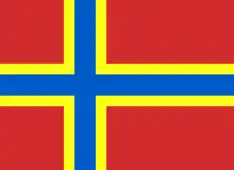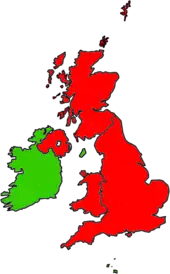< Portal:Scotland

The Scotland Portal

View from An Teallach
| Main Page | Selected articles 1 | Selected articles 2 | Selected biographies | Selected quotes | Selected pictures | Featured Content | Categories & Topics |
Selection of featured articles
![]()
 Image 1Cullen House is a large house, about 1 kilometre (0.6 mi) south-west of the coastal town of Cullen in Moray, Scotland. It was the seat of the Ogilvies of Findlater, who went on to become the Earls of Findlater and Seafield, and it remained in their family until 1982. Building work started on the house in 1600, incorporating some of the stonework of an earlier building on the site. The house has been extended and remodelled several times by prominent architects such as James Adam, John Adam, and David Bryce. It has been described by the architectural historian Charles McKean as "one of the grandest houses in Scotland" and is designated a Category A listed building. The grounds were enlarged in the 1820s when the entire village of Cullen, save for Cullen Old Church, was demolished to make way for improvements to the grounds by Ludovick Ogilvy-Grant, 5th Earl of Seafield; a new village, closer to the coast, was constructed for the inhabitants. Within the grounds are a bridge, a rotunda and a gatehouse, each of which is individually listed as a Category A structure.
Image 1Cullen House is a large house, about 1 kilometre (0.6 mi) south-west of the coastal town of Cullen in Moray, Scotland. It was the seat of the Ogilvies of Findlater, who went on to become the Earls of Findlater and Seafield, and it remained in their family until 1982. Building work started on the house in 1600, incorporating some of the stonework of an earlier building on the site. The house has been extended and remodelled several times by prominent architects such as James Adam, John Adam, and David Bryce. It has been described by the architectural historian Charles McKean as "one of the grandest houses in Scotland" and is designated a Category A listed building. The grounds were enlarged in the 1820s when the entire village of Cullen, save for Cullen Old Church, was demolished to make way for improvements to the grounds by Ludovick Ogilvy-Grant, 5th Earl of Seafield; a new village, closer to the coast, was constructed for the inhabitants. Within the grounds are a bridge, a rotunda and a gatehouse, each of which is individually listed as a Category A structure.
Twice in its history, the house has been captured and ransacked. It was taken by forces acting under the orders of the Marquess of Montrose in 1645 during the Wars of the Three Kingdoms. It was attacked again by Jacobite forces during the rising of 1745, shortly before they were defeated at the Battle of Culloden. (Full article...) Image 2
Image 2 1705 portrait
1705 portrait
Anne (6 February 1665 – 1 August 1714) was Queen of Great Britain and Ireland following the ratification of the Acts of Union on 1 May 1707, which merged the kingdoms of Scotland and England. Prior to this, she was Queen of England, Scotland, and Ireland from 8 March 1702.
Anne was born during the reign of her uncle King Charles II. Her father was Charles's younger brother and heir presumptive, James, whose suspected Roman Catholicism was unpopular in England. On Charles's instructions, Anne and her elder sister Mary were raised as Anglicans. Mary married their Dutch Protestant cousin, William III of Orange, in 1677, and Anne married the Lutheran Prince George of Denmark in 1683. On Charles's death in 1685, James succeeded to the throne, but just three years later he was deposed in the Glorious Revolution of 1688. Mary and William became joint monarchs. Although the sisters had been close, disagreements over Anne's finances, status, and choice of acquaintances arose shortly after Mary's accession and they became estranged. William and Mary had no children. After Mary's death in 1694, William reigned alone until his own death in 1702, when Anne succeeded him. (Full article...)![Image 3The Little Minch, home to the blue menThe blue men of the Minch, also known as storm kelpies (Scottish Gaelic: na fir ghorma Scottish Gaelic pronunciation: [nə fiɾʲ ˈɣɔɾɔmə]), are mythological creatures inhabiting the stretch of water between the northern Outer Hebrides and mainland Scotland, looking for sailors to drown and stricken boats to sink. They appear to be localised to the Minch and surrounding areas to the north and as far east as Wick, unknown in other parts of Scotland and without counterparts in the rest of the world.Apart from their blue colour, the mythical creatures look much like humans, and are about the same size. They have the power to create storms, but when the weather is fine they float sleeping on or just below the surface of the water. The blue men swim with their torsos raised out of the sea, twisting and diving as porpoises do. They are able to speak, and when a group approaches a ship its chief may shout two lines of poetry to the master of the vessel and challenge him to complete the verse. If the skipper fails in that task then the blue men will attempt to capsize his ship. (Full article...)](../../I/Blank.png.webp) Image 3
Image 3 The Little Minch, home to the blue men
The Little Minch, home to the blue men
The blue men of the Minch, also known as storm kelpies (Scottish Gaelic: na fir ghorma Scottish Gaelic pronunciation: [nə fiɾʲ ˈɣɔɾɔmə]), are mythological creatures inhabiting the stretch of water between the northern Outer Hebrides and mainland Scotland, looking for sailors to drown and stricken boats to sink. They appear to be localised to the Minch and surrounding areas to the north and as far east as Wick, unknown in other parts of Scotland and without counterparts in the rest of the world.
Apart from their blue colour, the mythical creatures look much like humans, and are about the same size. They have the power to create storms, but when the weather is fine they float sleeping on or just below the surface of the water. The blue men swim with their torsos raised out of the sea, twisting and diving as porpoises do. They are able to speak, and when a group approaches a ship its chief may shout two lines of poetry to the master of the vessel and challenge him to complete the verse. If the skipper fails in that task then the blue men will attempt to capsize his ship. (Full article...) Image 4"From the Doctor to My Son Thomas" is a viral video recorded by actor Peter Capaldi and sent to Thomas Goodall, an autistic nine-year-old boy in England, to console the child over grief from the death of Goodall's grandmother. Capaldi filmed the 42-second video in character as the Twelfth Doctor from the BBC science-fiction series Doctor Who. Capaldi's message had a positive effect on Thomas: he smiled for the first time since learning of his grandmother's death, and gained the courage to go to her funeral.
Image 4"From the Doctor to My Son Thomas" is a viral video recorded by actor Peter Capaldi and sent to Thomas Goodall, an autistic nine-year-old boy in England, to console the child over grief from the death of Goodall's grandmother. Capaldi filmed the 42-second video in character as the Twelfth Doctor from the BBC science-fiction series Doctor Who. Capaldi's message had a positive effect on Thomas: he smiled for the first time since learning of his grandmother's death, and gained the courage to go to her funeral.
Thomas' father Ross Goodall posted the video to YouTube on 6 November 2014, wanting to make the video available to his family, but had no idea it would become popular online. The video was viewed over 200,000 times in its first 48 hours online, and more than doubled the next day, and less than a week later it had over 900,000 total views, making it a viral video, with the responses becoming a global phenomenon. (Full article...) Image 5
Image 5.jpg.webp) Cromwell at Dunbar, by Andrew Carrick Gow
Cromwell at Dunbar, by Andrew Carrick Gow
The Anglo-Scottish war (1650–1652), also known as the Third Civil War, was the final conflict in the Wars of the Three Kingdoms, a series of armed conflicts and political machinations between shifting alliances of religious and political factions in England, Scotland and Ireland.
The 1650 English invasion of Scotland was a pre-emptive military incursion by the English Commonwealth's New Model Army, intended to allay the risk of Charles II invading England with a Scottish army. The First and Second English Civil Wars, in which English Royalists, loyal to Charles I, fought Parliamentarians for control of the country, took place between 1642 and 1648. When the Royalists were defeated for the second time the English government, exasperated by the duplicity of Charles I during negotiations, set up a High Court of Justice which found the King guilty of treason and executed him on 30 January 1649. At the time, England and Scotland were separate independent kingdoms, joined politically through a personal union; Charles I was, separately, both the king of Scotland, and the king of England. The Scots had fought in support of the English Parliamentarians in the First English Civil War, but sent an army in support of Charles I into England during the Second. The Parliament of Scotland, which had not been consulted before the execution, declared his son, Charles II, King of Britain. (Full article...)![Image 6A view of Neilston from the southwest, with the city of Glasgow in the distanceNeilston (Scots: Neilstoun, Scottish Gaelic: Baile Nèill, pronounced [paləˈnɛːʎ]) is a village and parish in East Renfrewshire in the west central Lowlands of Scotland. It is in the Levern Valley, two miles (three kilometres) southwest of Barrhead, 3+3⁄4 miles (6 kilometres) south of Paisley, and 5+3⁄4 miles (9.5 kilometres) south-southwest of Renfrew, at the southwestern fringe of the Greater Glasgow conurbation. Neilston is a dormitory village with a resident population of just over 5,000 people. Neilston is mentioned in documents from the 12th century, when the feudal lord Robert de Croc, endowed a chapel to Paisley Abbey to the North. Neilston Parish Church—a Category B listed building—is said to be on the site of this original chapel and has been at the centre of the community since 1163. Little remains of the original structure. Before industrialisation, Neilston was a scattered farming settlement composed of a series of single-storey houses, many of them thatched. Some domestic weaving was carried out using local flax. Water power from nearby streams ground corn and provided a suitable environment for bleaching the flax. (Full article...)](../../I/Blank.png.webp) Image 6
Image 6 A view of Neilston from the southwest, with the city of Glasgow in the distance
A view of Neilston from the southwest, with the city of Glasgow in the distance
Neilston (Scots: Neilstoun, Scottish Gaelic: Baile Nèill, pronounced [paləˈnɛːʎ]) is a village and parish in East Renfrewshire in the west central Lowlands of Scotland. It is in the Levern Valley, two miles (three kilometres) southwest of Barrhead, 3+3⁄4 miles (6 kilometres) south of Paisley, and 5+3⁄4 miles (9.5 kilometres) south-southwest of Renfrew, at the southwestern fringe of the Greater Glasgow conurbation. Neilston is a dormitory village with a resident population of just over 5,000 people.
Neilston is mentioned in documents from the 12th century, when the feudal lord Robert de Croc, endowed a chapel to Paisley Abbey to the North. Neilston Parish Church—a Category B listed building—is said to be on the site of this original chapel and has been at the centre of the community since 1163. Little remains of the original structure. Before industrialisation, Neilston was a scattered farming settlement composed of a series of single-storey houses, many of them thatched. Some domestic weaving was carried out using local flax. Water power from nearby streams ground corn and provided a suitable environment for bleaching the flax. (Full article...) Image 7
Image 7_underway_c1947.jpg.webp) Profile view of Vanguard underway
Profile view of Vanguard underway
HMS Vanguard was a British fast battleship built during the Second World War and commissioned after the war ended. She was the largest and fastest of the Royal Navy's battleships, the only ship of her class, and the last battleship to be built.
The Royal Navy anticipated being outnumbered by the combined German and Japanese battleships in the early 1940s, and had therefore started building the Lion-class battleships. However, the time-consuming construction of the triple-16-inch (406 mm) turrets for the Lion class would delay their completion until 1943 at the earliest. The British had enough 15-inch (381 mm) guns and turrets in storage to allow one ship of a modified Lion-class design with four twin-15-inch turrets to be completed faster than the Lion-class vessels that had already been laid down. Work on Vanguard was started and stopped several times during the war, and her design was revised several times during her construction to reflect war experience. These stoppages and changes prevented her from being completed before the end of the war. (Full article...) Image 8
Image 8.jpg.webp) Royal Oak at anchor in 1937
Royal Oak at anchor in 1937
HMS Royal Oak was one of five Revenge-class battleships built for the Royal Navy during the First World War. Completed in 1916, the ship first saw combat at the Battle of Jutland as part of the Grand Fleet. In peacetime, she served in the Atlantic, Home and Mediterranean fleets, more than once coming under accidental attack. Royal Oak drew worldwide attention in 1928 when her senior officers were controversially court-martialled, an event that brought considerable embarrassment to what was then the world's largest navy. Attempts to modernise Royal Oak throughout her 25-year career could not fix her fundamental lack of speed and, by the start of the Second World War, she was no longer suitable for front-line duty.
On 14 October 1939, Royal Oak was anchored at Scapa Flow in Orkney, Scotland, when she was torpedoed by the German submarine U-47. Of Royal Oak's complement of 1,234 men and boys, 835 were killed that night or died later of their wounds. The loss of the outdated ship—the first of five Royal Navy battleships and battlecruisers sunk in the Second World War—did little to affect the numerical superiority enjoyed by the British navy and its Allies, but it had a considerable effect on wartime morale. The raid made an immediate celebrity and war hero of the U-boat commander, Günther Prien, who became the first German submarine officer to be awarded the Knight's Cross of the Iron Cross. Before the sinking of Royal Oak, the Royal Navy had considered the naval base at Scapa Flow impregnable to submarine attack, but U-47's raid demonstrated that the German navy was capable of bringing the war to British home waters. The shock resulted in rapid changes to dockland security and the construction of the Churchill Barriers around Scapa Flow, with the added advantage of being topped by roads running between the islands. (Full article...) Image 9
Image 9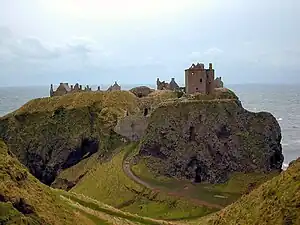 Dunnottar Castle in the Mearns occupies one of the best defensive locations in Great Britain. The site was in use throughout the High Middle Ages, and the castle itself dates to the fourteenth century.
Dunnottar Castle in the Mearns occupies one of the best defensive locations in Great Britain. The site was in use throughout the High Middle Ages, and the castle itself dates to the fourteenth century.
The High Middle Ages of Scotland encompass Scotland in the era between the death of Domnall II in 900 AD and the death of King Alexander III in 1286, which was an indirect cause of the Wars of Scottish Independence.
At the close of the ninth century, various competing kingdoms occupied the territory of modern Scotland. Scandinavian influence was dominant in the northern and western islands, Brythonic culture in the southwest, the Anglo-Saxon or English Kingdom of Northumbria in the southeast and the Pictish and Gaelic Kingdom of Alba in the east, north of the River Forth. By the tenth and eleventh centuries, northern Great Britain was increasingly dominated by Gaelic culture, and by the Gaelic regal lordship of Alba, known in Latin as either Albania or Scotia, and in English as "Scotland". From its base in the east, this kingdom acquired control of the lands lying to the south and ultimately the west and much of the north. It had a flourishing culture, comprising part of the larger Gaelic-speaking world and an economy dominated by agriculture and trade. (Full article...) Image 10
Image 10 Portrait of McGregor
Portrait of McGregor
William McGregor (13 April 1846 – 20 December 1911) was a Scottish association football administrator in the Victorian era who is regarded as the founder of the Football League (now English Football League), the first organised association football league in the world.
After moving from Perthshire to Birmingham to set up business as a draper, McGregor became involved with local football club Aston Villa, which he helped to establish as one of the leading teams in England. He served the club for over 20 years in various capacities, including president, director and chairman. In 1888, frustrated by the regular cancellation of Villa's matches, McGregor organised a meeting of representatives of England's leading clubs, which led to the formation of the Football League, giving member clubs a guaranteed fixture list each season. This was instrumental in the transition of football from an amateur pastime to a professional business. (Full article...) Image 11
Image 11
Mary, Queen of Scots (8 December 1542 – 8 February 1587), also known as Mary Stuart or Mary I of Scotland, was Queen of Scotland from 14 December 1542 until her forced abdication in 1567.
The only surviving legitimate child of James V of Scotland, Mary was six days old when her father died and she inherited the throne. During her childhood, Scotland was governed by regents, first by the heir to the throne, James Hamilton, Earl of Arran, and then by her mother, Mary of Guise. In 1548, she was betrothed to Francis, the Dauphin of France, and was sent to be brought up in France, where she would be safe from invading English forces during the Rough Wooing. Mary married Francis in 1558, becoming queen consort of France from his accession in 1559 until his death in December 1560. Widowed, Mary returned to Scotland in August 1561. The tense religious and political climate following the Scottish Reformation that Mary encountered on her return to Scotland was further agitated by prominent Scots such as John Knox, who openly questioned whether her subjects had a duty to obey her. The early years of her personal rule were marked by pragmatism, tolerance, and moderation. She issued a proclamation accepting the religious settlement in Scotland as she had found it upon her return, retained advisers such as James Stewart, Earl of Moray (her illegitimate half-brother), and William Maitland of Lethington, and governed as the Catholic monarch of a Protestant kingdom. (Full article...) Image 12The Second War of Scottish Independence broke out in 1332 when Edward Balliol led an English-backed invasion of Scotland. Balliol, the son of former Scottish king John Balliol, was attempting to make good his claim to the Scottish throne. He was opposed by Scots loyal to the occupant of the throne, eight-year-old David II. At the Battle of Dupplin Moor Balliol's force defeated a Scottish army ten times their size and Balliol was crowned king. Within three months David's partisans had regrouped and forced Balliol out of Scotland. He appealed to the English king, Edward III, who invaded Scotland in 1333 and besieged the important trading town of Berwick. A large Scottish army attempted to relieve it but was heavily defeated at the Battle of Halidon Hill. Balliol established his authority over most of Scotland, ceded to England the eight counties of south-east Scotland and did homage to Edward for the rest of the country as a fief.
Image 12The Second War of Scottish Independence broke out in 1332 when Edward Balliol led an English-backed invasion of Scotland. Balliol, the son of former Scottish king John Balliol, was attempting to make good his claim to the Scottish throne. He was opposed by Scots loyal to the occupant of the throne, eight-year-old David II. At the Battle of Dupplin Moor Balliol's force defeated a Scottish army ten times their size and Balliol was crowned king. Within three months David's partisans had regrouped and forced Balliol out of Scotland. He appealed to the English king, Edward III, who invaded Scotland in 1333 and besieged the important trading town of Berwick. A large Scottish army attempted to relieve it but was heavily defeated at the Battle of Halidon Hill. Balliol established his authority over most of Scotland, ceded to England the eight counties of south-east Scotland and did homage to Edward for the rest of the country as a fief.
As allies of Scotland via the Auld Alliance, the French were unhappy about an English expansion into Scotland and so covertly supported and financed David's loyalists. Balliol's allies fell out among themselves and he lost control of most of Scotland again by late 1334. In early 1335 the French attempted to broker a peace. However, the Scots were unable to agree a position and Edward prevaricated while building a large army. He invaded in July and again overran most of Scotland. Tensions with France increased. Further French-sponsored peace talks failed in 1336 and in May 1337 the French king, Philip VI, engineered a clear break between France and England, starting the Hundred Years' War. The Anglo-Scottish war became a subsidiary theatre of this larger Anglo-French war. Edward sent what troops he could spare to Scotland, in spite of which the English slowly lost ground in Scotland as they were forced to focus on the French theatre. Achieving his majority David returned to Scotland from France in 1341 and by 1342 the English had been cleared from north of the border. (Full article...) Image 13
Image 13%252C_by_Peter_Lely.jpg.webp) Portrait by Peter Lely, 1648–49
Portrait by Peter Lely, 1648–49
Elizabeth Maitland, Duchess of Lauderdale, 2nd Countess of Dysart (née Murray; 28 September 1626 – 5 June 1698), was a Scottish noblewoman. She was the eldest daughter of William Murray and his wife Catherine, the Earl and Countess of Dysart. She was raised in English court circles during the years leading up to the English Civil War and received a well-rounded education from her parents. Her first husband was Lionel Tollemache, by whom she had eleven children. In 1672, three years after Lionel's death, she married John Maitland and resumed her close connection with the restored court.
After her father's death Maitland held the title of Countess of Dysart in her own right and from the date of her remarriage in 1672 she was also the Duchess of Lauderdale. She was famous for the political influence she exercised and for her support for Charles II during his exile. As a member of the secret Royalist organisation known as the Sealed Knot, she actively supported the return of the monarchy after the execution of Charles I. She was also a lifelong patron of artists, particularly Peter Lely. She died at the age of 71 at her family home, Ham House near Richmond by the Thames, and is buried in the nearby parish church. (Full article...) Image 14Burnt Candlemas was a failed invasion of Scotland in early 1356 by an English army commanded by King Edward III, and was the last campaign of the Second War of Scottish Independence. Tensions on the Anglo-Scottish border led to a military build-up by both sides in 1355. In September a nine-month truce was agreed, and most of the English forces left for northern France to take part in a campaign of the concurrent Hundred Years' War. A few days after agreeing the truce, the Scots, encouraged and subsidised by the French, broke it, invading and devastating Northumberland. In late December the Scots escaladed and captured the important English-held border town of Berwick-on-Tweed and laid siege to its castle. The English army redeployed from France to Newcastle in northern England.
Image 14Burnt Candlemas was a failed invasion of Scotland in early 1356 by an English army commanded by King Edward III, and was the last campaign of the Second War of Scottish Independence. Tensions on the Anglo-Scottish border led to a military build-up by both sides in 1355. In September a nine-month truce was agreed, and most of the English forces left for northern France to take part in a campaign of the concurrent Hundred Years' War. A few days after agreeing the truce, the Scots, encouraged and subsidised by the French, broke it, invading and devastating Northumberland. In late December the Scots escaladed and captured the important English-held border town of Berwick-on-Tweed and laid siege to its castle. The English army redeployed from France to Newcastle in northern England.
The English advanced to Berwick, retaking the town, and moved to Roxburgh in southern Scotland by mid-January 1356. From there they advanced on Edinburgh, leaving a trail of devastation 50–60 miles (80–100 km) wide behind them. The Scots practised a scorched earth policy, refusing battle and removing or destroying all food in their own territory. The English reached and burnt Edinburgh and were resupplied by sea at Haddington. Edward intended to march on Perth, but contrary winds prevented the movement of the fleet he would need to supply his army. While waiting for a better wind, the English despoiled Lothian so thoroughly that the episode became known as "Burnt Candlemas". This was a reference to the custom of the time of taking one's annual stock of candles to the local church on 2 February to be blessed in a ceremony known as candlemas; they were then used over the rest of the year. (Full article...) Image 15
Image 15_crop.jpg.webp) Argus in harbour in 1918, painted in dazzle camouflage
Argus in harbour in 1918, painted in dazzle camouflage
HMS Argus was a British aircraft carrier that served in the Royal Navy from 1918 to 1944. She was converted from an ocean liner that was under construction when the First World War began and became the first aircraft carrier with a full-length flight deck that allowed wheeled aircraft to take off and land. After commissioning, the ship was involved for several years in the development of the optimum design for other aircraft carriers. Argus also evaluated various types of arresting gear, general procedures needed to operate a number of aircraft in concert and fleet tactics. The ship was too top-heavy as originally built, and had to be modified to improve her stability in the mid-1920s. She spent one brief deployment on the China Station in the late 1920s before being placed in reserve for budgetary reasons.
Argus was recommissioned and partially modernised shortly before the Second World War and served as a training ship for deck-landing practice until June 1940. The following month she made the first of her many ferry trips to the Western Mediterranean to fly off fighters to Malta; she was largely occupied in this task for the next two years. The ship also delivered aircraft to Murmansk, Russia, Takoradi in the Gold Coast, and Reykjavík, Iceland. By 1942, the Royal Navy was very short of aircraft carriers, and Argus was pressed into front-line service despite her lack of speed and armament. In June, she participated in Operation Harpoon, providing air cover for the Malta-bound convoy. In November, the ship provided air cover during Operation Torch, the invasion of French North Africa, and was slightly damaged by a bomb. After returning to the UK for repairs, Argus was used again for deck-landing practice until late September 1944. In December, she became an accommodation ship, and was listed for disposal in mid-1946. The ship was sold in late 1946 and scrapped the following year. (Full article...) Image 16
Image 16_-_March_17%252C_1924.jpg.webp) Hood, 17 March 1924
Hood, 17 March 1924
HMS Hood (pennant number 51) was a battlecruiser of the Royal Navy (RN). Hood was the first of the planned four Admiral-class battlecruisers to be built during the First World War. Already under construction when the Battle of Jutland occurred in mid-1916, that battle revealed serious flaws in her design despite drastic revisions before she was completed four years later. For this reason, she was the only ship of her class to be completed, as the Admiralty decided it would be better to start with a clean design on succeeding battlecruisers, leading to the never-built G-3 class. Despite the appearance of newer and more modern ships, Hood remained the largest warship in the world for 20 years after her commissioning, and her prestige was reflected in her nickname, "The Mighty Hood".
Hood was involved in many showing-the-flag exercises between her commissioning in 1920 and the outbreak of war in 1939, including training exercises in the Mediterranean Sea and a circumnavigation of the globe with the Special Service Squadron in 1923 and 1924. She was attached to the Mediterranean Fleet following the outbreak of the Second Italo-Ethiopian War in 1935. When the Spanish Civil War broke out the following year, Hood was officially assigned to the Mediterranean Fleet until she had to return to Britain in 1939 for an overhaul. By this time, advances in naval gunnery had reduced Hood's usefulness. She was scheduled to undergo a major rebuild in 1941 to correct these issues, but the outbreak of the Second World War in September 1939 kept the ship in service without the upgrades. (Full article...) Image 17
Image 17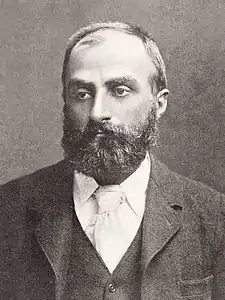
William Speirs Bruce FRSE (1 August 1867 – 28 October 1921) was a British naturalist, polar scientist and oceanographer who organized and led the Scottish National Antarctic Expedition (SNAE, 1902–04) to the South Orkney Islands and the Weddell Sea. Among other achievements, the expedition established the first permanent weather station in Antarctica. Bruce later founded the Scottish Oceanographical Laboratory in Edinburgh, but his plans for a transcontinental Antarctic march via the South Pole were abandoned because of lack of public and financial support.
In 1892 Bruce gave up his medical studies at the University of Edinburgh and joined the Dundee Whaling Expedition to Antarctica as a scientific assistant. This was followed by Arctic voyages to Novaya Zemlya, Spitsbergen and Franz Josef Land. In 1899 Bruce, by then Britain's most experienced polar scientist, applied for a post on Robert Falcon Scott's Discovery Expedition, but delays over this appointment and clashes with Royal Geographical Society (RGS) president Sir Clements Markham led him instead to organise his own expedition, and earned him the permanent enmity of the geographical establishment in London. Although Bruce received various awards for his polar work, including an honorary doctorate from the University of Aberdeen, neither he nor any of his SNAE colleagues were recommended by the RGS for the prestigious Polar Medal. (Full article...) Image 18
Image 18-p162-Nuckalavee-illustr-J_Torrance_(cropped).jpg.webp) The nuckelavee chasing an islander, painting by James Torrance (1859–1916).
The nuckelavee chasing an islander, painting by James Torrance (1859–1916).
The nuckelavee ( /nʌklɑːˈviː/) or nuckalavee is a horse-like demon from Orcadian folklore that combines equine and human elements. British folklorist Katharine Briggs called it "the nastiest" of all the demons of Scotland's Northern Isles. The nuckelavee's breath was thought to wilt crops and sicken livestock, and the creature was held responsible for droughts and epidemics on land despite being predominantly a sea-dweller.
A graphic description of the nuckelavee as it appears on land was given by an islander who claimed to have had a confrontation with it, but accounts describing the details of the creature's appearance are inconsistent. In common with many other sea-monsters, it is unable to tolerate fresh water, therefore, those it is pursuing have only to cross a river or stream to be rid of it. The nuckelavee is kept in confinement during the summer months by the Mither o' the Sea, an ancient Orcadian spirit, and the only one able to control it. (Full article...) Image 19
Image 19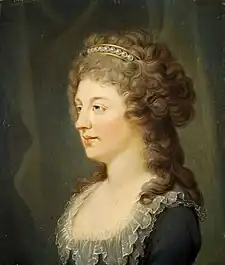 Portrait by Hugh Douglas Hamilton, Scottish National Portrait Gallery
Portrait by Hugh Douglas Hamilton, Scottish National Portrait Gallery
Charlotte Stuart, styled Duchess of Albany (29 October 1753 – 17 November 1789) was the illegitimate daughter of the Jacobite pretender Prince Charles Edward Stuart ("Bonnie Prince Charlie" or the "Young Pretender") and his only child to survive infancy.
Her mother was Clementina Walkinshaw, who was mistress to the Prince from 1752 until 1760. After years of abuse, Clementina left him, taking Charlotte with her. Charlotte spent most of her life in French convents, estranged from a father who refused to make any provision for her. Unable to marry, she herself became a mistress with illegitimate children, taking Ferdinand de Rohan, Archbishop of Bordeaux, as her lover. (Full article...) Image 20
Image 20 Gunn at his own-named catering facility club at Carrow Road in November 2007
Gunn at his own-named catering facility club at Carrow Road in November 2007
Bryan James Gunn (born 22 December 1963) is a Scottish former professional goalkeeper and football manager. After learning his trade with Aberdeen in the early 1980s, he spent most of his playing career at Norwich City, the club with which he came to be most closely associated. This was followed by a brief spell back in Scotland with Hibernian before his retirement as a player in 1998.
Gunn feels the peak of his playing career was making what he calls the save of his life in the UEFA Cup match against Bayern Munich in 1993. This event was called the summit of Norwich City's history by The Independent. He is one of only nine Norwich players to win the club's Player of the Year award twice. He was made an inaugural member of Norwich City's Hall of Fame. He was a member of the Scotland national football team, making six appearances for his country in the early 1990s. (Full article...) Image 21
Image 21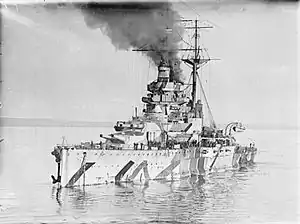 Ramillies at anchor during the First World War, painted in dazzle camouflage
Ramillies at anchor during the First World War, painted in dazzle camouflage
HMS Ramillies (pennant number: 07) was one of five Revenge-class super-dreadnought battleships built for the Royal Navy during the First World War. They were developments of the Queen Elizabeth-class battleships, with reductions in size and speed to offset increases in the armour protection whilst retaining the same main battery of eight 15-inch (381 mm) guns. Completed in late 1917, Ramillies saw no combat during the war as both the British and the German fleets had adopted a more cautious strategy by this time owing to the increasing threat of naval mines and submarines.
Ramillies spent the 1920s and 1930s alternating between the Atlantic Fleet and the Mediterranean Fleet. Whilst serving in the Mediterranean and Black Seas in the early 1920s, the ship went to Turkey twice in response to crises arising from the Greco-Turkish War, including the Great Fire of Smyrna in 1922. She also saw limited involvement during the Allied intervention in the Russian Civil War. The ship's interwar career was otherwise uneventful. With the outbreak of the Second World War in September 1939, Ramillies was initially assigned to escort duties in the North Atlantic. In May 1940, she was transferred to the Mediterranean Fleet as war with Italy loomed. After the Italians entered the war in June, Ramillies bombarded Italian ports in North Africa, escorted convoys to Malta, and supported the Taranto raid in November. (Full article...) Image 22
Image 22 Portrait of Lady Grange by Sir John Baptiste de Medina c. 1710
Portrait of Lady Grange by Sir John Baptiste de Medina c. 1710
Rachel Chiesley (baptised 4 February 1679 – 12 May 1745), usually known as Lady Grange, was the wife of Lord Grange, a Scottish lawyer with Jacobite sympathies. After 25 years of marriage and nine children, the Granges separated acrimoniously. When Lady Grange produced letters that she claimed were evidence of his treasonable plottings against the Hanoverian government in London, her husband had her kidnapped in 1732. She was incarcerated in various remote locations on the western seaboard of Scotland, including the Monach Isles, Skye and St Kilda.
Lady Grange's father was convicted of murder and she is known to have had a violent temper; initially her absence seems to have caused little comment. News of her plight eventually reached her home town of Edinburgh and an unsuccessful rescue attempt was undertaken by her lawyer, Thomas Hope of Rankeillor. She died in captivity, after being in effect imprisoned for over 13 years. Her life has been remembered in poetry, prose and plays. (Full article...) Image 23
Image 23.jpg.webp)
Margaret Macpherson Grant (27 April 1834 – 14 April 1877) was a Scottish heiress and philanthropist. Born in Aberlour parish to a local surgeon, she was educated in Hampshire, and was left an only child when her elder brother died in India in 1852. Two years later, she inherited a large fortune from her uncle, Alexander Grant, an Aberlour-born planter and merchant who had become rich in Jamaica.
Macpherson Grant took up residence in Aberlour House, which had been built for her uncle by William Robertson. She lived unconventionally for a woman of her time, dressing in a manner one newspaper called "manly", and entering into what was described as a form of marriage with a female companion, Charlotte Temple, whom she had met in London in 1864. Macpherson Grant donated generously to charitable enterprises, especially those associated with the Scottish Episcopal Church, establishing an orphanage (now the Aberlour Child Care Trust) and founding St Margaret's Episcopal Church in Aberlour. She drank heavily, and despite attempts by friends and family members to persuade her to stop, she always relapsed into alcoholism. (Full article...) Image 24
Image 24
The fauna of Scotland is generally typical of the northwest European part of the Palearctic realm, although several of the country's larger mammals were hunted to extinction in historic times and human activity has also led to various species of wildlife being introduced. Scotland's diverse temperate environments support 62 species of wild mammals, including a population of wild cats, important numbers of grey and harbour seals and the most northerly colony of bottlenose dolphins in the world.
Many populations of moorland birds, including the black and red grouse live here, and the country has internationally significant nesting grounds for seabirds such as the northern gannet. The golden eagle has become a national icon, and white-tailed eagles and ospreys have recently re-colonised the land. The Scottish crossbill is the only endemic vertebrate species in the UK. (Full article...) Image 25
Image 25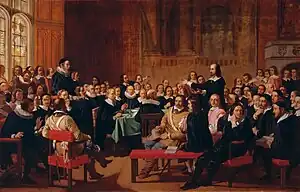 This painting by John Rogers Herbert depicts a particularly controversial speech before the Assembly by Philip Nye against presbyterian church government.
This painting by John Rogers Herbert depicts a particularly controversial speech before the Assembly by Philip Nye against presbyterian church government.
The Westminster Assembly of Divines was a council of divines (theologians) and members of the English Parliament appointed from 1643 to 1653 to restructure the Church of England. Several Scots also attended, and the Assembly's work was adopted by the Church of Scotland. As many as 121 ministers were called to the Assembly, with nineteen others added later to replace those who did not attend or could no longer attend. It produced a new Form of Church Government, a Confession of Faith or statement of belief, two catechisms or manuals for religious instruction (Shorter and Larger), and a liturgical manual, the Directory for Public Worship, for the Churches of England and Scotland. The Confession and catechisms were adopted as doctrinal standards in the Church of Scotland and other Presbyterian churches, where they remain normative. Amended versions of the Confession were also adopted in Congregational and Baptist churches in England and New England in the seventeenth and eighteenth centuries. The Confession became influential throughout the English-speaking world, but especially in American Protestant theology.
The Assembly was called by the Long Parliament before and during the beginning of the First English Civil War. The Long Parliament was influenced by Puritanism, a religious movement which sought to further reform the church. They were opposed to the religious policies of King Charles I and William Laud, Archbishop of Canterbury. As part of a military alliance with Scotland, Parliament agreed that the outcome of the Assembly would bring the English Church into closer conformity with the Church of Scotland. The Scottish Church was governed by a system of elected assemblies of elders called presbyterianism, rather than rule by bishops, called episcopalianism, which was used in the English church. Scottish commissioners attended and advised the Assembly as part of the agreement. Disagreements over church government caused open division in the Assembly, despite attempts to maintain unity. The party of divines who favoured presbyterianism was in the majority, but the congregationalist party, which held greater influence in the military, favoured autonomy for individual congregations rather than the subjection of congregations to regional and national assemblies entailed in presbyterianism. Parliament eventually adopted a presbyterian form of government but lacked the power to implement it. During the Restoration of the monarchy in 1660, all of the documents of the Assembly were repudiated and episcopal church government was reinstated in England. (Full article...)![Image 26A 19th-century reproduction of an impression of Donnchadh's seal, surviving from a Melrose charter, depicting [according to antiquarian Henry Laing] a "winged dragon"; the inscription reads SIGILLUM DUNCANI FILII GILLEBER.. ("The seal of Donnchadh son of Gille-Brighde")Donnchadh (Scottish Gaelic pronunciation: [ˈt̪ɔn̪ˠɔxəɣ]; Latin: Duncanus; English: Duncan) was a Gall-Gaidhil prince and Scottish magnate in what is now south-western Scotland, whose career stretched from the last quarter of the 12th century until his death in 1250. His father, Gille-Brighde of Galloway, and his uncle, Uhtred of Galloway, were the two rival sons of Fergus, Prince or Lord of Galloway. As a result of Gille-Brighde's conflict with Uhtred and the Scottish monarch William the Lion, Donnchadh became a hostage of King Henry II of England. He probably remained in England for almost a decade before returning north on the death of his father. Although denied succession to all the lands of Galloway, he was granted lordship over Carrick in the north.Allied to John de Courcy, Donnchadh fought battles in Ireland and acquired land there that he subsequently lost. A patron of religious houses, particularly Melrose Abbey and North Berwick priory nunnery, he attempted to establish a monastery in his own territory, at Crossraguel. He married the daughter of Alan fitz Walter, a leading member of the family later known as the House of Stewart—future monarchs of Scotland and England. Donnchadh was the first mormaer or earl of Carrick, a region he ruled for more than six decades, making him one of the longest serving magnates in medieval Scotland. His descendants include the Bruce and Stewart Kings of Scotland, and probably the Campbell Dukes of Argyll. (Full article...)](../../I/Blank.png.webp) Image 26
Image 26 A 19th-century reproduction of an impression of Donnchadh's seal, surviving from a Melrose charter, depicting [according to antiquarian Henry Laing] a "winged dragon"; the inscription reads SIGILLUM DUNCANI FILII GILLEBER.. ("The seal of Donnchadh son of Gille-Brighde")
A 19th-century reproduction of an impression of Donnchadh's seal, surviving from a Melrose charter, depicting [according to antiquarian Henry Laing] a "winged dragon"; the inscription reads SIGILLUM DUNCANI FILII GILLEBER.. ("The seal of Donnchadh son of Gille-Brighde")
Donnchadh (Scottish Gaelic pronunciation: [ˈt̪ɔn̪ˠɔxəɣ]; Latin: Duncanus; English: Duncan) was a Gall-Gaidhil prince and Scottish magnate in what is now south-western Scotland, whose career stretched from the last quarter of the 12th century until his death in 1250. His father, Gille-Brighde of Galloway, and his uncle, Uhtred of Galloway, were the two rival sons of Fergus, Prince or Lord of Galloway. As a result of Gille-Brighde's conflict with Uhtred and the Scottish monarch William the Lion, Donnchadh became a hostage of King Henry II of England. He probably remained in England for almost a decade before returning north on the death of his father. Although denied succession to all the lands of Galloway, he was granted lordship over Carrick in the north.
Allied to John de Courcy, Donnchadh fought battles in Ireland and acquired land there that he subsequently lost. A patron of religious houses, particularly Melrose Abbey and North Berwick priory nunnery, he attempted to establish a monastery in his own territory, at Crossraguel. He married the daughter of Alan fitz Walter, a leading member of the family later known as the House of Stewart—future monarchs of Scotland and England. Donnchadh was the first mormaer or earl of Carrick, a region he ruled for more than six decades, making him one of the longest serving magnates in medieval Scotland. His descendants include the Bruce and Stewart Kings of Scotland, and probably the Campbell Dukes of Argyll. (Full article...) Image 27
Image 27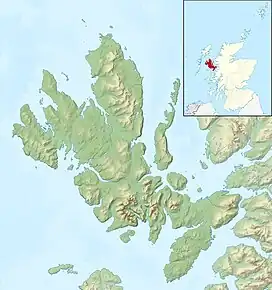
The Isle of Skye, or simply Skye (/skaɪ/; Scottish Gaelic: An t-Eilean Sgitheanach or Eilean a' Cheò), is the largest and northernmost of the major islands in the Inner Hebrides of Scotland. The island's peninsulas radiate from a mountainous hub dominated by the Cuillin, the rocky slopes of which provide some of the most dramatic mountain scenery in the country. Although Sgitheanach has been suggested to describe a winged shape, no definitive agreement exists as to the name's origins.
The island has been occupied since the Mesolithic period, and over its history has been occupied at various times by Celtic tribes including the Picts and the Gaels, Scandinavian Vikings, and most notably the powerful integrated Norse-Gaels clans of
MacLeod and MacDonald. The island was considered to be under Norwegian suzerainty until the 1266 Treaty of Perth, which transferred control over to Scotland. (Full article...) Image 28
Image 28.jpg.webp) 19th-century engraving of Knox
19th-century engraving of Knox
John Knox (c. 1514 – 24 November 1572) was a Scottish minister, Reformed theologian, and writer who was a leader of the country's Reformation. He was the founder of the Presbyterian Church of Scotland.
Born in Giffordgate, a street in Haddington, East Lothian, Knox is believed to have been educated at the University of St Andrews and worked as a notary-priest. Influenced by early church reformers such as George Wishart, he joined the movement to reform the Scottish church. He was caught up in the ecclesiastical and political events that involved the murder of Cardinal David Beaton in 1546 and the intervention of the regent Mary of Guise. He was taken prisoner by French forces the following year and exiled to England on his release in 1549. (Full article...) Image 29
Image 29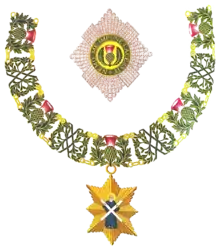 Insignia of a Knight of the Most Ancient and Most Noble Order of the Thistle
Insignia of a Knight of the Most Ancient and Most Noble Order of the Thistle
The Most Ancient and Most Noble Order of the Thistle is an order of chivalry associated with Scotland. The current version of the order was founded in 1687 by King James VII of Scotland, who asserted that he was reviving an earlier order. The order consists of the sovereign and sixteen knights and ladies, as well as certain "extra" knights (members of the British royal family and foreign monarchs). The sovereign alone grants membership of the order; they are not advised by the government, as occurs with most other orders.
The order's primary emblem is the thistle, the national flower of Scotland. The motto is Nemo me impune lacessit (Latin for "No one provokes me with impunity"). The same motto appears on the royal coat of arms of the United Kingdom for use in Scotland and pound coins minted in 1984, 1989, 1994, and 1999 (since withdrawn), and is also the motto of the Royal Scots Dragoon Guards, the Scots Guards, the Royal Regiment of Scotland, and The Black Watch (Royal Highland Regiment) of Canada. The patron saint of the order is St Andrew. (Full article...)![Image 30Satellite image of northern Britain and Ireland showing the approximate area of Dál Riata (shaded)Áedán mac Gabráin (pronounced [ˈaiðaːn mak ˈɡavɾaːnʲ] in Old Irish; Irish: Aodhán mac Gabhráin), also written as Aedan, was a king of Dál Riata from c. 574 until c. 609 AD. The kingdom of Dál Riata was situated in modern Argyll and Bute, Scotland, and parts of County Antrim, Ireland. Genealogies record that Áedán was a son of Gabrán mac Domangairt.He was a contemporary of Saint Columba, and much that is recorded of his life and career comes from hagiography such as Adomnán of Iona's Life of Saint Columba. Áedán appears as a character in Old Irish and Middle Irish language works of prose and verse, some now lost. (Full article...)](../../I/Blank.png.webp) Image 30
Image 30 Satellite image of northern Britain and Ireland showing the approximate area of Dál Riata (shaded)
Satellite image of northern Britain and Ireland showing the approximate area of Dál Riata (shaded)
Áedán mac Gabráin (pronounced [ˈaiðaːn mak ˈɡavɾaːnʲ] in Old Irish; Irish: Aodhán mac Gabhráin), also written as Aedan, was a king of Dál Riata from c. 574 until c. 609 AD. The kingdom of Dál Riata was situated in modern Argyll and Bute, Scotland, and parts of County Antrim, Ireland. Genealogies record that Áedán was a son of Gabrán mac Domangairt.
He was a contemporary of Saint Columba, and much that is recorded of his life and career comes from hagiography such as Adomnán of Iona's Life of Saint Columba. Áedán appears as a character in Old Irish and Middle Irish language works of prose and verse, some now lost. (Full article...) Image 31Nebula Science Fiction was the first Scottish science fiction magazine. It was published from 1952 to 1959, and was edited by Peter Hamilton, a young Scot who was able to take advantage of spare capacity at his parents' printing company, Crownpoint, to launch the magazine. Because Hamilton could only print Nebula when Crownpoint had no other work, the schedule was initially erratic. In 1955 he moved the printing to a Dublin-based firm, and the schedule became a little more regular, with a steady monthly run beginning in 1958 that lasted into the following year. Nebula's circulation was international, with only a quarter of the sales in the United Kingdom; this led to disaster when South Africa and Australia imposed import controls on foreign periodicals at the end of the 1950s. Excise duties imposed in the UK added to Hamilton's financial burdens, and he was rapidly forced to close the magazine. The last issue was dated June 1959.
Image 31Nebula Science Fiction was the first Scottish science fiction magazine. It was published from 1952 to 1959, and was edited by Peter Hamilton, a young Scot who was able to take advantage of spare capacity at his parents' printing company, Crownpoint, to launch the magazine. Because Hamilton could only print Nebula when Crownpoint had no other work, the schedule was initially erratic. In 1955 he moved the printing to a Dublin-based firm, and the schedule became a little more regular, with a steady monthly run beginning in 1958 that lasted into the following year. Nebula's circulation was international, with only a quarter of the sales in the United Kingdom; this led to disaster when South Africa and Australia imposed import controls on foreign periodicals at the end of the 1950s. Excise duties imposed in the UK added to Hamilton's financial burdens, and he was rapidly forced to close the magazine. The last issue was dated June 1959.
The magazine was popular with writers, partly because Hamilton went to great lengths to encourage new writers, and partly because he paid better rates per word than much of his competition. Initially he could not compete with the American market, but he offered a bonus for the most popular story in the issue, and was eventually able to match the leading American magazines. He published the first stories of several well-known writers, including Robert Silverberg, Brian Aldiss, and Bob Shaw. Nebula was also a fan favourite: author Ken Bulmer recalled that it became "what many fans regard as the best-loved British SF magazine". (Full article...) Image 32
Image 32 Portrait by John de Critz, 1605
Portrait by John de Critz, 1605
Anne of Denmark (Danish: Anna; 12 December 1574 – 2 March 1619) was the wife of King James VI and I. She was Queen of Scotland from their marriage on 20 August 1589 and Queen of England and Ireland from the union of the Scottish and English crowns on 24 March 1603 until her death in 1619.
The second daughter of King Frederick II of Denmark and Sophie of Mecklenburg-Güstrow, Anne married James at age 14. They had three children who survived infancy: Henry Frederick, Prince of Wales, who predeceased his parents; Princess Elizabeth, who became Queen of Bohemia; and James's future successor, Charles I. Anne demonstrated an independent streak and a willingness to use factional Scottish politics in her conflicts with James over the custody of Prince Henry and his treatment of her friend Beatrix Ruthven. Anne appears to have loved James at first, but the couple gradually drifted and eventually lived apart, though mutual respect and a degree of affection survived. (Full article...) Image 33
Image 33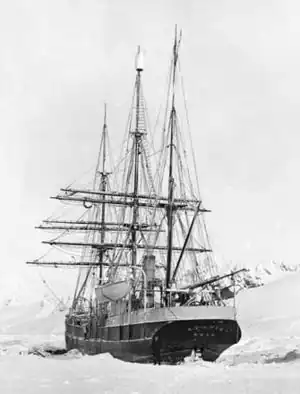
The Scottish National Antarctic Expedition (SNAE), 1902–1904, was organised and led by William Speirs Bruce, a natural scientist and former medical student from the University of Edinburgh. Although overshadowed in terms of prestige by Robert Falcon Scott's concurrent Discovery Expedition, the SNAE completed a full programme of exploration and scientific work. Its achievements included the establishment of a staffed meteorological station, the first in Antarctic territory, and the discovery of new land to the east of the Weddell Sea. Its large collection of biological and geological specimens, together with those from Bruce's earlier travels, led to the establishment of the Scottish Oceanographical Laboratory in 1906.
Bruce had spent most of the 1890s engaged on expeditions to the Antarctic and Arctic regions, and by 1899 was Britain's most experienced polar scientist. In March of that year, he applied to join the Discovery Expedition; however, his proposal to extend that expedition's field of work into the Weddell Sea quadrant, using a second ship, was dismissed as "mischievous rivalry" by Royal Geographical Society (RGS) president Sir Clements Markham. Bruce reacted by obtaining independent finance; his venture was supported and promoted by the Royal Scottish Geographical Society. (Full article...) Image 34
Image 34 Sir Hector MacLean's charge at Inverkeithing (1873 illustration)
Sir Hector MacLean's charge at Inverkeithing (1873 illustration)
The Battle of Inverkeithing was fought on 20 July 1651 between an English army under John Lambert and a Scottish army led by James Holborne as part of an English invasion of Scotland. The battle was fought near the isthmus of the Ferry Peninsula, to the south of Inverkeithing, after which it is named.
An English Parliamentary regime had tried, convicted, and executed Charles I, who was king of both Scotland and England in a personal union, in January 1649. The Scots recognised his son, also named Charles, as king of Britain and set about recruiting an army. An English army, under Oliver Cromwell, invaded Scotland in July 1650. The Scottish army, commanded by David Leslie, refused battle until 3 September when it was heavily defeated at the Battle of Dunbar. The English occupied Edinburgh and the Scots withdrew to the choke point of Stirling. For nearly a year all attempts to storm or bypass Stirling, or to draw the Scots out into another battle, failed. On 17 July 1651 1,600 English soldiers crossed the Firth of Forth at its narrowest point in specially constructed flat-bottomed boats and landed at North Queensferry on the Ferry Peninsula. The Scots sent forces to pen the English in and the English reinforced their landing. On 20 July the Scots moved against the English and in a short engagement were routed. (Full article...)![Image 35David I or Dauíd mac Maíl Choluim (Modern: Daibhidh I mac [Mhaoil] Chaluim; c. 1084 – 24 May 1153) was a 12th-century ruler who was Prince of the Cumbrians from 1113 to 1124 and later King of Scotland from 1124 to 1153. The youngest son of Malcolm III and Margaret of Wessex, David spent most of his childhood in Scotland, but was exiled to England temporarily in 1093. Perhaps after 1100, he became a dependent at the court of King Henry I of England. There he was influenced by the Norman-French culture of the court.When David's brother Alexander I died in 1124, David chose, with the backing of Henry I, to take the Kingdom of Scotland (Alba) for himself. He was forced to engage in warfare against his rival and nephew, Máel Coluim mac Alaxandair. Subduing the latter seems to have taken David ten years, a struggle that involved the destruction of Óengus, Mormaer of Moray. David's victory allowed expansion of control over more distant regions theoretically part of his Kingdom. After the death of his former patron Henry I, David supported the claims of Henry's daughter and his own niece, Empress Matilda, to the throne of England. In the process, he came into conflict with King Stephen and was able to expand his power in northern England, despite his defeat at the Battle of the Standard in 1138. David I is a saint of the Catholic Church, with his feast day celebrated on 24 May. (Full article...)](../../I/Blank.png.webp) Image 35
Image 35.jpg.webp)
David I or Dauíd mac Maíl Choluim (Modern: Daibhidh I mac [Mhaoil] Chaluim; c. 1084 – 24 May 1153) was a 12th-century ruler who was Prince of the Cumbrians from 1113 to 1124 and later King of Scotland from 1124 to 1153. The youngest son of Malcolm III and Margaret of Wessex, David spent most of his childhood in Scotland, but was exiled to England temporarily in 1093. Perhaps after 1100, he became a dependent at the court of King Henry I of England. There he was influenced by the Norman-French culture of the court.
When David's brother Alexander I died in 1124, David chose, with the backing of Henry I, to take the Kingdom of Scotland (Alba) for himself. He was forced to engage in warfare against his rival and nephew, Máel Coluim mac Alaxandair. Subduing the latter seems to have taken David ten years, a struggle that involved the destruction of Óengus, Mormaer of Moray. David's victory allowed expansion of control over more distant regions theoretically part of his Kingdom. After the death of his former patron Henry I, David supported the claims of Henry's daughter and his own niece, Empress Matilda, to the throne of England. In the process, he came into conflict with King Stephen and was able to expand his power in northern England, despite his defeat at the Battle of the Standard in 1138. David I is a saint of the Catholic Church, with his feast day celebrated on 24 May. (Full article...) Image 36
Image 36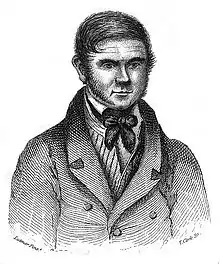 Burke
Burke
The Burke and Hare murders were a series of sixteen killings committed over a period of about ten months in 1828 in Edinburgh, Scotland. They were undertaken by William Burke and William Hare, who sold the corpses to Robert Knox for dissection at his anatomy lectures.
Edinburgh was a leading European centre of anatomical study in the early 19th century, in a time when the demand for cadavers led to a shortfall in legal supply. Scottish law required that corpses used for medical research should only come from those who had died in prison, suicide victims, or from foundlings and orphans. The shortage of corpses led to an increase in body snatching by what were known as "resurrection men". Measures to ensure graves were left undisturbed—such as the use of mortsafes—exacerbated the shortage. When a lodger in Hare's house died, he turned to his friend Burke for advice and they decided to sell the body to Knox. They received what was, for them, the generous sum of £7 10s. A little over two months later, when Hare was concerned that a lodger with a fever would deter others from staying in the house, he and Burke murdered her and sold the body to Knox. The men continued their murder spree, probably with the knowledge of their wives. Burke and Hare's actions were uncovered after other lodgers discovered their last victim, Margaret Docherty, and contacted the police. (Full article...) Image 37In the United Kingdom, representative peers were those peers elected by the members of the Peerage of Scotland and the Peerage of Ireland to sit in the British House of Lords. Until 1999, all members of the Peerage of England held the right to sit in the House of Lords; they did not elect a limited group of representatives. All peers who were created after 1707 as Peers of Great Britain and after 1801 as Peers of the United Kingdom held the same right to sit in the House of Lords.
Image 37In the United Kingdom, representative peers were those peers elected by the members of the Peerage of Scotland and the Peerage of Ireland to sit in the British House of Lords. Until 1999, all members of the Peerage of England held the right to sit in the House of Lords; they did not elect a limited group of representatives. All peers who were created after 1707 as Peers of Great Britain and after 1801 as Peers of the United Kingdom held the same right to sit in the House of Lords.
Representative peers were introduced in 1707, when the Kingdom of England and the Kingdom of Scotland were united into the Kingdom of Great Britain. At the time there were 168 English and 154 Scottish peers. The English peers feared that the House of Lords would be swamped by the Scottish element, and consequently the election of a small number of representative peers to represent Scotland was negotiated. A similar arrangement was adopted when the Kingdom of Great Britain and the Kingdom of Ireland merged into the United Kingdom of Great Britain and Ireland in January 1801. (Full article...) Image 38
Image 38 Portrait attributed to John de Critz, c. 1605
Portrait attributed to John de Critz, c. 1605
James VI and I (James Charles Stuart; 19 June 1566 – 27 March 1625) was King of Scotland as James VI from 24 July 1567 and King of England and Ireland as James I from the union of the Scottish and English crowns on 24 March 1603 until his death in 1625. Although he long tried to get both countries to adopt a closer political union, the kingdoms of Scotland and England remained individual sovereign states, with their own parliaments, judiciaries, and laws, both ruled by James in personal union.
James was the son of Mary, Queen of Scots, and a great-great-grandson of Henry VII, King of England and Lord of Ireland, and thus a potential successor to all three thrones. He succeeded to the Scottish throne at the age of thirteen months, after his mother was forced to abdicate in his favour. Four different regents governed during his minority, which ended officially in 1578, though he did not gain full control of his government until 1583. In 1589, he married Anne of Denmark. Three of their children survived to adulthood: Henry Frederick, Elizabeth, and Charles. In 1603, James succeeded his cousin Elizabeth I, the last Tudor monarch of England and Ireland, who died childless. He continued to reign in all three kingdoms for 22 years, a period known as the Jacobean era, until his death in 1625. After the Union of the Crowns, he based himself in England (the largest of the three realms) from 1603, returning to Scotland only once, in 1617, and styled himself "King of Great Britain and Ireland". He was a major advocate of a single parliament for England and Scotland. In his reign, the Plantation of Ulster and English colonisation of the Americas began. (Full article...) Image 39
Image 39 Constantine II King of Scotland (Alba)
Constantine II King of Scotland (Alba)
Causantín mac Áeda (Modern Gaelic: Còiseam mac Aoidh, anglicised Constantine II; born no later than 879; died 952) was an early King of Scotland, known then by the Gaelic name Alba. The Kingdom of Alba, a name which first appears in Constantine's lifetime, was situated in modern-day Northern Scotland.
The core of the kingdom was formed by the lands around the River Tay. Its southern limit was the River Forth, northwards it extended towards the Moray Firth and perhaps to Caithness, while its western limits are uncertain. Constantine's grandfather Kenneth I of Scotland (Cináed mac Ailpín, died 858) was the first of the family recorded as a king, but as king of the Picts. This change of title, from king of the Picts to king of Alba, is part of a broader transformation of Pictland and the origins of the Kingdom of Alba are traced to Constantine's lifetime. (Full article...) Image 40
Image 40 Portrait by Richard Stone, 1986
Portrait by Richard Stone, 1986
Elizabeth Angela Marguerite Bowes-Lyon (4 August 1900 – 30 March 2002) was Queen of the United Kingdom and the Dominions of the British Commonwealth from 11 December 1936 to 6 February 1952 as the wife of King George VI. She was concurrently the last Empress of India until the British Raj was dissolved in August 1947. After her husband died, she was officially known as Queen Elizabeth The Queen Mother, to avoid confusion with her daughter, Queen Elizabeth II.
Born into a family of British nobility, Elizabeth came to prominence in 1923 when she married Prince Albert, Duke of York, the second son of King George V and Queen Mary. The couple and their daughters, Elizabeth and Margaret, embodied traditional ideas of family and public service. The Duchess undertook a variety of public engagements and became known for her consistently cheerful countenance. (Full article...) Image 41
Image 41.jpg.webp) Portrait c. 1963
Portrait c. 1963
Alexander Frederick Douglas-Home, Baron Home of the Hirsel KT, PC (/ˈhjuːm/; 2 July 1903 – 9 October 1995), styled as Lord Dunglass between 1918 and 1951 and the Earl of Home from 1951 until 1963, was a British statesman and Conservative politician who served as Prime Minister of the United Kingdom from 1963 to 1964. He is notable for being the last prime minister to hold office while being a member of the House of Lords, before renouncing his peerage and taking up a seat in the House of Commons for the remainder of his premiership. His reputation, however, rests more on his two stints as Foreign Secretary than on his brief premiership.
Within six years of first entering the House of Commons in 1931, Douglas-Home (then called by the courtesy title Lord Dunglass) became a parliamentary aide to Neville Chamberlain, witnessing first-hand Chamberlain's efforts as prime minister to preserve peace through appeasement in the two years before the outbreak of the Second World War. In 1940 Dunglass was diagnosed with spinal tuberculosis and was immobilised for two years. By the later stages of the war he had recovered enough to resume his political career, but he lost his seat in the general election of 1945. He regained it in 1950, but the following year he left the Commons when, on the death of his father, he inherited the earldom of Home and thereby became a member of the House of Lords. Under the premierships of Winston Churchill, Anthony Eden and Harold Macmillan he was appointed to a series of increasingly senior posts, including Leader of the House of Lords and Foreign Secretary. In the latter post, which he held from 1960 to 1963, he supported United States resolve in the Cuban Missile Crisis and in August 1963 was the United Kingdom's signatory to the Partial Nuclear Test Ban Treaty. (Full article...) Image 42
Image 42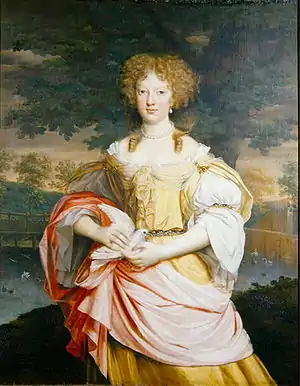 Portrait of Mary Wilbraham, Weston Park
Portrait of Mary Wilbraham, Weston Park
John Michael Wright (May 1617 – July 1694) was an English painter, mainly of portraits in the Baroque style. Born and raised in London, Wright trained in Edinburgh under the Scots painter George Jamesone, and sometimes described himself as Scottish in documents. He acquired a considerable reputation as an artist and scholar during a long sojourn in Rome. There he was admitted to the Accademia di San Luca and was associated with some of the leading artists of his generation. He was engaged by Archduke Leopold Wilhelm of Austria, the governor of the Spanish Netherlands, to acquire artworks in Oliver Cromwell's England in 1655.
He took up permanent residence in England from 1656 and served as court painter before and after the English Restoration. A convert to Roman Catholicism, he was a favourite of the restored Stuart court, a client of both Charles II and James II, and was a witness to many of the political manoeuvrings of the era. In the final years of the Stuart monarchy he returned to Rome as part of an embassy to Pope Innocent XI. (Full article...) Image 43
Image 43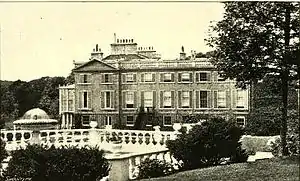 A side view of Pitfour House, c. late 19th century
A side view of Pitfour House, c. late 19th century
The Pitfour Estate, in the Buchan area of North-East Scotland, was an ancient barony encompassing most of the extensive Longside Parish, stretching from St Fergus to New Pitsligo. It was purchased in 1700 by James Ferguson of Badifurrow, who became the first Laird of Pitfour.
The estate was substantially renovated by Ferguson and the following two generations of his family. At the height of its development in the 18th and 19th centuries the 50-square-mile (130 km2) property had several extravagant features including a two-mile racecourse, an artificial lake and an observatory. The original mansion house was extended before being rebuilt. The surrounding parklands were landscaped, major renovations were undertaken, and follies such as a small replica Temple of Theseus were constructed, in which George Ferguson, the fifth laird, was thought to keep alligators in a cold bath. (Full article...) Image 44Asahi (朝日, Morning Sun) was a pre-dreadnought battleship built for the Imperial Japanese Navy (IJN) in the late 1890s. As Japan lacked the industrial capacity to build such warships itself, the ship was designed and built in the United Kingdom. Shortly after her arrival in Japan, she became flagship of the Standing Fleet, the IJN's primary combat fleet. She participated in every major naval battle of the Russo-Japanese War of 1904–1905 and was lightly damaged during the Battle of the Yellow Sea and the Battle of Tsushima. Asahi saw no combat during World War I, although the ship participated in the Siberian Intervention in 1918.
Image 44Asahi (朝日, Morning Sun) was a pre-dreadnought battleship built for the Imperial Japanese Navy (IJN) in the late 1890s. As Japan lacked the industrial capacity to build such warships itself, the ship was designed and built in the United Kingdom. Shortly after her arrival in Japan, she became flagship of the Standing Fleet, the IJN's primary combat fleet. She participated in every major naval battle of the Russo-Japanese War of 1904–1905 and was lightly damaged during the Battle of the Yellow Sea and the Battle of Tsushima. Asahi saw no combat during World War I, although the ship participated in the Siberian Intervention in 1918.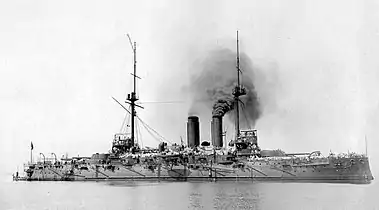 Asahi at anchor about 1906
Asahi at anchor about 1906
Reclassified as a coastal defence ship in 1921, Asahi was disarmed two years later to meet the terms of the Washington Naval Treaty, after which she served as a training and submarine depot ship. She was modified into a submarine salvage and rescue ship before being placed in reserve in 1928. Asahi was recommissioned in late 1937, after the start of the Second Sino-Japanese War, and used to transport Japanese troops. In 1938, she was converted into a repair ship and based first at Japanese-occupied Shanghai, China, and then Cam Ranh Bay, French Indochina, from late 1938 to 1941. The ship was transferred to occupied Singapore in early 1942 to repair a damaged light cruiser and ordered to return home in May. She was sunk en route by the American submarine USS Salmon, although most of her crew survived. (Full article...) Image 45The Battle of Halidon Hill took place on 19 July 1333 when a Scottish army under Sir Archibald Douglas attacked an English army commanded by King Edward III of England (r. 1327–1377) and was heavily defeated. The year before, Edward Balliol had seized the Scottish Crown from five-year-old David II (r. 1329–1371), surreptitiously supported by Edward III. This marked the start of the Second War of Scottish Independence. Balliol was shortly expelled from Scotland by a popular uprising, which Edward III used as a casus belli, invading Scotland in 1333. The immediate target was the strategically-important border town of Berwick-upon-Tweed, which the English besieged in March.
Image 45The Battle of Halidon Hill took place on 19 July 1333 when a Scottish army under Sir Archibald Douglas attacked an English army commanded by King Edward III of England (r. 1327–1377) and was heavily defeated. The year before, Edward Balliol had seized the Scottish Crown from five-year-old David II (r. 1329–1371), surreptitiously supported by Edward III. This marked the start of the Second War of Scottish Independence. Balliol was shortly expelled from Scotland by a popular uprising, which Edward III used as a casus belli, invading Scotland in 1333. The immediate target was the strategically-important border town of Berwick-upon-Tweed, which the English besieged in March.
A large Scottish army advanced to relieve the town. They attempted and failed to draw the English away from Berwick. By mid-July, knowing Berwick was on the verge of surrender and aware they were much stronger than the English, the Scots attacked. They unsuccessfully manoeuvred for position and then launched an assault on the English, who had taken up a favourable defensive position. English longbowmen caused heavy Scottish casualties during their approach, and when the Scots came into contact with the English infantry, the fight was short. The Scottish formations collapsed and the Scots fled in disorder. The English men-at-arms mounted and pursued the Scots for eight miles, causing further heavy casualties. The Scottish commander and many of the Scots' senior nobility were killed during the battle. (Full article...) Image 46Walter Weir Wilson Donaldson (2 February 1907 – 24 May 1973) was a Scottish professional snooker and billiards player. He contested eight consecutive world championship finals against Fred Davis from 1947 to 1954, and won the title in 1947 and 1950. Donaldson was known for his long potting and his consistency when playing, and had an aversion to the use of side. In 2012, he was inducted posthumously into the World Professional Billiards and Snooker Association's World Snooker Hall of Fame.
Image 46Walter Weir Wilson Donaldson (2 February 1907 – 24 May 1973) was a Scottish professional snooker and billiards player. He contested eight consecutive world championship finals against Fred Davis from 1947 to 1954, and won the title in 1947 and 1950. Donaldson was known for his long potting and his consistency when playing, and had an aversion to the use of side. In 2012, he was inducted posthumously into the World Professional Billiards and Snooker Association's World Snooker Hall of Fame.
Donaldson became a professional player shortly after winning the under-16's British Junior English Billiards Championship in 1922 and won the Scottish professional billiards title six times. He first competed in the World Snooker Championship in 1933, but after a heavy defeat by Joe Davis did not enter again until 1939. After serving in the Fourth Indian Division during World War II, Donaldson entered the 1946 World Championship, where he lost to Davis in his first match. As a player that did not reach the championship final, he was eligible to enter the 1946 Albany Club Professional Snooker Tournament, which he won. Following Joe Davis's retirement from the World Championship in 1946, Donaldson practised intensively and won the 1947 Championship by defeating Fred Davis in the final. Davis won the following two championships, with Donaldson taking the next and then being runner-up to Davis for the next four years. Donaldson then retired from World Championship competition, although he continued to play in the News of the World Snooker Tournament until 1959. (Full article...) Image 47The Scotland men's national football team represents Scotland in men's international football and is controlled by the Scottish Football Association. It competes in the three major professional tournaments: the FIFA World Cup, UEFA Nations League and the UEFA European Championship. Scotland, as a country of the United Kingdom, is not a member of the International Olympic Committee, and therefore the national team does not compete in the Olympic Games. The majority of Scotland's home matches are played at the national stadium, Hampden Park.
Image 47The Scotland men's national football team represents Scotland in men's international football and is controlled by the Scottish Football Association. It competes in the three major professional tournaments: the FIFA World Cup, UEFA Nations League and the UEFA European Championship. Scotland, as a country of the United Kingdom, is not a member of the International Olympic Committee, and therefore the national team does not compete in the Olympic Games. The majority of Scotland's home matches are played at the national stadium, Hampden Park.
Scotland is the joint oldest national football team in the world, alongside England, whom they played in the world's first international football match in 1872. Scotland has a long-standing rivalry with England, whom they played annually from 1872 until 1989. The teams have met only nine times since then, most recently in a friendly in September 2023. (Full article...) Image 48
Image 48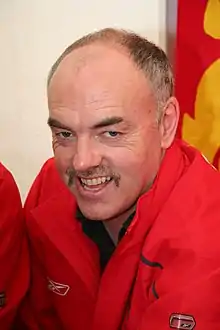 Wark in 2006
Wark in 2006
John Wark (born 4 August 1957) is a Scottish former footballer who spent most of his playing time with Ipswich Town. He won a record four Player of the Year awards before becoming one of the four inaugural members of the club's Hall of Fame. Wark had long spells at the club, which bookended his career, and a third, brief interlude dividing his briefer periods at Liverpool and Middlesbrough. A versatile player, Wark played most of his professional games as a midfielder, although he sometimes played as a central defender and on occasion as a striker.
Born in Glasgow, Wark represented Scotland in international football, winning 29 caps and scoring seven goals. This included selection for Scotland in the 1982 FIFA World Cup in which he made three appearances and scored twice. (Full article...) Image 49
Image 49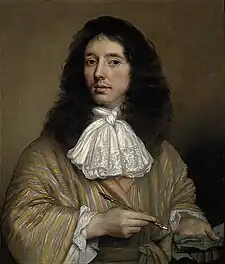 Painting of Bruce by John Michael Wright, c. 1664
Painting of Bruce by John Michael Wright, c. 1664
Sir William Bruce of Kinross, 1st Baronet (c. 1630 – 1710), was a Scottish gentleman-architect, "the effective founder of classical architecture in Scotland," as Howard Colvin observes. As a key figure in introducing the Palladian style into Scotland, he has been compared to the pioneering English architects Inigo Jones and Christopher Wren, and to the contemporaneous introducers of French style in English domestic architecture, Hugh May and Sir Roger Pratt.
Bruce was a merchant in Rotterdam during the 1650s, and played a role in the Restoration of Charles II in 1659. He carried messages between the exiled king and General Monck, and his loyalty to the king was rewarded with lucrative official appointments, including that of Surveyor General of the King's Works in Scotland, effectively making Bruce the "king's architect". His patrons included John Maitland, 1st Duke of Lauderdale, the most powerful man in Scotland at that time, and Bruce rose to become a member of Parliament, and briefly sat on the Scottish Privy Council. (Full article...) Image 50
Image 50.jpg.webp) Cromwell at Dunbar, 1886, by Andrew Carrick Gow
Cromwell at Dunbar, 1886, by Andrew Carrick Gow
The Battle of Dunbar was fought between the English New Model Army, under Oliver Cromwell, and a Scottish army commanded by David Leslie on 3 September 1650 near Dunbar, Scotland. The battle resulted in a decisive victory for the English. It was the first major battle of the 1650 invasion of Scotland, which was triggered by Scotland's acceptance of Charles II as king of Britain after the beheading of his father, Charles I on 30 January 1649.
After Charles I's execution, the English Rump Parliament established a republican Commonwealth in England. When their erstwhile ally, Scotland, recognised Charles II as king of all of Britain on 1 May 1650 and began recruiting an army to support him, the English dispatched the New Model Army, under the command of Cromwell. The army crossed into Scotland on 22 July, with a force of over 16,000 men. The Scots withdrew to Edinburgh, stripping the land of provisions. Cromwell attempted to draw the Scots out into a set piece battle, but they resisted, and Cromwell was unable to break through their defensive line. At the end of August, with his army weakened through disease and lack of food, Cromwell withdrew to the port of Dunbar. The Scottish army followed and took up an unassailable position on Doon Hill, overlooking the town. On 2 September, the Scots advanced towards Dunbar and the English took up positions outside the town. The English army was greatly weakened by sickness and lack of food, while many of the Scots' most experienced men had been dismissed in religious purges. (Full article...)
Selection of good articles
![]()
 Image 1
Image 1
Orkney (/ˈɔːrkni/; Scots: Orkney; Old Norse: Orkneyjar; Norn: Orknøjar), also known as the Orkney Islands (archaically "The Orkneys") is an archipelago in the Northern Isles of Scotland, situated off the north coast of the island of Great Britain. Orkney is 10 miles (16 km) north of the coast of Caithness and has about 70 islands, of which 20 are inhabited. The largest island, the Mainland, has an area of 523 square kilometres (202 sq mi), making it the sixth-largest Scottish island and the tenth-largest island in the British Isles. Orkney's largest settlement, and also its administrative centre, is Kirkwall.
Orkney is one of the 32 council areas of Scotland, as well as a constituency of the Scottish Parliament, a lieutenancy area, and an historic county. The local council is Orkney Islands Council, one of only three councils in Scotland with a majority of elected members who are independents. (Full article...) Image 2
Image 2 Interior dome of the McEwan Hall after restoration in 2017
Interior dome of the McEwan Hall after restoration in 2017
The University of Edinburgh (Scots: University o Edinburgh, Scottish Gaelic: Oilthigh Dhùn Èideann; abbreviated as Edin. in post-nominals) is a public research university based in Edinburgh, Scotland. Founded by the town council under the authority of a royal charter of King James VI in 1582 and officially opened in 1583, it is one of Scotland's four ancient universities and the sixth-oldest university in continuous operation in the English-speaking world. The university played an important role in Edinburgh becoming a chief intellectual centre during the Scottish Enlightenment and contributed to the city being nicknamed the "Athens of the North."
The three main global university rankings (QS, THE, and ARWU) all place Edinburgh within their respective top 40. It is a member of several associations of research-intensive universities, including the Coimbra Group, League of European Research Universities, Russell Group, Una Europa, and Universitas 21. In the fiscal year ending 31 July 2022, it had a total income of £1.262 billion, of which £331.6 million was from research grants and contracts. It has the third-largest endowment in the UK, behind only Cambridge and Oxford. The university occupies five main campuses in the city of Edinburgh, which include many buildings of historical and architectural significance such as those in the Old Town. (Full article...) Image 3
Image 3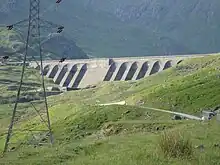 The dam containing the upper reservoir
The dam containing the upper reservoir
The Cruachan Power Station (also known as the Cruachan Dam) is a pumped-storage hydroelectric power station in Argyll and Bute, Scotland. The scheme can provide 440 MW of power and produced 705 GWh in 2009.
The turbine hall is located inside Ben Cruachan, and the scheme takes water between Cruachan Reservoir to Loch Awe, a height difference of 396 m (1,299 ft). It is one of only four pumped storage power stations in the United Kingdom, and is capable of providing a black start capability to the National Grid. (Full article...) Image 4
Image 4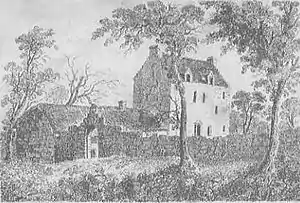 Bargarran House, home of Christian Shaw
Bargarran House, home of Christian Shaw
The Paisley witches, also known as the Bargarran witches or the Renfrewshire witches, were tried in Paisley, Renfrewshire, central Scotland, in 1697. Eleven-year-old Christian Shaw, daughter of the Laird of Bargarran, complained of being tormented by some local witches; they included one of her family's servants, Catherine Campbell, whom she had reported to her mother after witnessing her steal a drink of milk.
Seven people – Margaret Lang, John Lindsay, James Lindsay, John Reid, Catherine Campbell, Margaret Fulton, and Agnes Naismith – were found guilty of having bewitched Shaw and were condemned to death. One subsequently committed suicide by hanging himself in his prison cell. The other six were hanged and then burned on the Gallow Green in Paisley on 10 June 1697, the last mass execution for witchcraft in western Europe. (Full article...) Image 5Edinburgh Zoo (Scottish Gaelic: Sù Dhùn Èideann), formerly the Scottish National Zoological Park, is an 82-acre (33 ha) non-profit zoological park in the Corstorphine area of Edinburgh, Scotland.
Image 5Edinburgh Zoo (Scottish Gaelic: Sù Dhùn Èideann), formerly the Scottish National Zoological Park, is an 82-acre (33 ha) non-profit zoological park in the Corstorphine area of Edinburgh, Scotland.
The zoo is positioned on the south-facing slopes of Corstorphine Hill, giving extensive views of the city. Established in 1913, and owned by the Royal Zoological Society of Scotland, it receives over 600,000 visitors a year, which makes it one of Scotland's most popular paid-for tourist attractions. As well as catering for tourists and locals, the zoo is involved in many scientific pursuits, such as captive breeding of endangered animals, researching into animal behaviour, and active participation in various conservation programmes around the world. (Full article...) Image 6The Calendar (New Style) Act 1750 (24 Geo. 2. c. 23), also known as Chesterfield's Act or (in American usage) the British Calendar Act of 1751, is an Act of the Parliament of Great Britain. Its purpose was for Great Britain and the British Empire to adopt the Gregorian calendar (in effect). The Act also rectified other dating anomalies, such as changing the start of the legal year from 25 March to 1 January.
Image 6The Calendar (New Style) Act 1750 (24 Geo. 2. c. 23), also known as Chesterfield's Act or (in American usage) the British Calendar Act of 1751, is an Act of the Parliament of Great Britain. Its purpose was for Great Britain and the British Empire to adopt the Gregorian calendar (in effect). The Act also rectified other dating anomalies, such as changing the start of the legal year from 25 March to 1 January.
The Act elided eleven days from September 1752. It ordered that religious feast days be held on their traditional dates – for example, Christmas Day remained on 25 December. (Easter is a moveable feast: the Act specifies how its date should be calculated.) It ordered that civil and market days – for example the quarter days on which rent was due, salaries paid and new labour contracts agreed – be moved forward in the calendar by eleven days so that no-one should gain or lose by the change and that markets match the agricultural season. It is for this reason that the UK personal tax year ends on 5 April, being eleven days on from the original quarter-day of 25 March (Lady Day). (Full article...) Image 7
Image 7.jpg.webp)
John Gregorson Campbell (1836 – 22 November 1891) was a Scottish folklorist and Free Church minister at the Tiree and Coll parishes in Argyll, Scotland. An avid collector of traditional stories, he became Secretary to the Ossianic Society of Glasgow University in the mid-1850s. Ill health had prevented him taking up employment as a Minister when he was initially approved to preach by the Presbytery of Glasgow in 1858 and later after he was appointed to Tiree by the Duke of Argyll in 1861, parishioners objected to his manner of preaching.
Several of the anecdotes he amassed were published in magazines and, just before his death, work began on collating the first of four compendiums of the tales; three were published a few years after his death. He was fluent in several languages, including Scottish Gaelic, and transcribed the legends precisely as dictated by the narrators. (Full article...) Image 8
Image 8 Arms of Sir Andrew Dudley, KG
Arms of Sir Andrew Dudley, KG
Sir Andrew Dudley, KG (c. 1507 – 1559) was an English soldier, courtier, and diplomat. A younger brother of John Dudley, 1st Duke of Northumberland, he served in Henry VIII's navy and obtained court offices under Edward VI. In 1547–1548 he acted as admiral of the fleet and participated in the War of the Rough Wooing in Scotland, where he commanded the English garrison of Broughty Castle. He was appointed captain of the fortress of Guînes in the Pale of Calais in late 1551. There he got involved in a dispute with the Lord Deputy of Calais, which ended only when both men were replaced in October 1552.
In October 1549 Andrew Dudley became one of Edward VI's Chief Gentlemen of the Privy Chamber and later keeper of the Palace of Westminster, in which function he was responsible for the Royal Wardrobe and Privy Purse. In early 1553 he was sent on a diplomatic mission to the Emperor Charles V to suggest peace talks between France and the Empire. Andrew Dudley was bethrothed to Margaret Clifford, a first cousin of Lady Jane Grey, in June 1553; yet his marriage plans came to naught with the accession of Mary I, and on 19 August 1553 he was condemned to death for his part in his brother's attempt to establish Lady Jane on the English throne. Released in January 1555, he lived in London until his death in 1559. (Full article...) Image 9Colin Campbell Mitchell (17 November 1925 – 20 July 1996) was a British Army soldier and politician. He became a public figure in 1967 as the commanding officer of the 1st Battalion of the Argyll and Sutherland Highlanders. Forces under his command reoccupied the Crater district of Aden which had been taken over by local police mutineers in what became known as "the last battle of the British empire". The reoccupation and subsequent control of the Crater were controversial and Mitchell resigned his army commission in 1968. Subsequently, he became a Conservative Member of Parliament and served one term from 1970 to February 1974. After participation in a failed business venture he subsequently worked as a security and military consultant. In 1989 Mitchell took a leading role in the Halo Trust, a not-for-profit organisation undertaking mine clearance in former war zones. (Full article...)
Image 9Colin Campbell Mitchell (17 November 1925 – 20 July 1996) was a British Army soldier and politician. He became a public figure in 1967 as the commanding officer of the 1st Battalion of the Argyll and Sutherland Highlanders. Forces under his command reoccupied the Crater district of Aden which had been taken over by local police mutineers in what became known as "the last battle of the British empire". The reoccupation and subsequent control of the Crater were controversial and Mitchell resigned his army commission in 1968. Subsequently, he became a Conservative Member of Parliament and served one term from 1970 to February 1974. After participation in a failed business venture he subsequently worked as a security and military consultant. In 1989 Mitchell took a leading role in the Halo Trust, a not-for-profit organisation undertaking mine clearance in former war zones. (Full article...) Image 10
Image 10 Drawing of the aftermath of the Tradeston Flour Mills explosion in the Illustrated London News on 20 July 1872
Drawing of the aftermath of the Tradeston Flour Mills explosion in the Illustrated London News on 20 July 1872
On 9 July 1872 the Tradeston Flour Mills, in Glasgow, Scotland, exploded. Eighteen people died, and at least sixteen were injured. An investigation suggested that the explosion was caused by the grain feed to a pair of millstones stopping, causing them to rub against each other, resulting in a spark or fire igniting the grain dust in the air. That fire was then drawn by a fan into an "exhaust box" designed to collect grain dust, which then ignited, causing a second explosion which destroyed the building. At the time, there were general concerns about similar incidents worldwide, so the incident and investigation were widely reported across the world. (Full article...) Image 11Alexander Buchan (died 17 April 1769) was a Scottish landscape artist. He is known for his participation in the 1768–1771 first voyage of James Cook aboard HMS Endeavour, where he was one of the artists in the entourage of botanist Joseph Banks. Buchan had epilepsy. On the journey, he had two documented seizures, the first during an expedition in Tierra del Fuego. Buchan died after the second seizure, shortly after Endeavour's arrival at Tahiti, and was buried at sea. Buchan produced landscapes, coastal views, ethnographic drawings and natural history drawings. He is best known for illustrations of the people of Tierra del Fuego, some of which were engraved for publication in accounts of the voyage. All of his drawings from the voyage were taken by his employer Joseph Banks and are now in the British Library and the Natural History Museum, London. (Full article...)
Image 11Alexander Buchan (died 17 April 1769) was a Scottish landscape artist. He is known for his participation in the 1768–1771 first voyage of James Cook aboard HMS Endeavour, where he was one of the artists in the entourage of botanist Joseph Banks. Buchan had epilepsy. On the journey, he had two documented seizures, the first during an expedition in Tierra del Fuego. Buchan died after the second seizure, shortly after Endeavour's arrival at Tahiti, and was buried at sea. Buchan produced landscapes, coastal views, ethnographic drawings and natural history drawings. He is best known for illustrations of the people of Tierra del Fuego, some of which were engraved for publication in accounts of the voyage. All of his drawings from the voyage were taken by his employer Joseph Banks and are now in the British Library and the Natural History Museum, London. (Full article...) Image 12
Image 12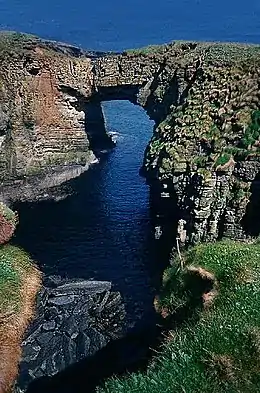 The seas of Orkney are calm during the periods of Sea Mither's reign.
The seas of Orkney are calm during the periods of Sea Mither's reign.
Sea Mither, or Mither of the Sea, is a mythical being of Orcadian folklore that lives in the sea during summer, when she confines the demonic nuckelavee to the ocean depths. Each spring she battles with her arch-enemy Teran, another spirit of Orcadian legend capable of causing severe winter storms, to gain control of the seas and the weather. Eventually Sea Mither overcomes Teran and sends him to the depths of the ocean, but the effort of keeping him confined there along with her other benevolent labours during the summer exhaust her, until in the autumn Teran takes advantage of her weakness to wrest control from her once again.
Stories of the Sea Mither and Teran are among Orkney's oldest legends, perhaps invented to explain the vagaries of weather and other naturally occurring events. In Shetland, fishermen petition Sea Mither to afford them protection from the Devil. (Full article...) Image 13
Image 13.jpg.webp) Aerial view of Ibrox Stadium, 2021
Aerial view of Ibrox Stadium, 2021
Ibrox Stadium (Scottish Gaelic: Stadium Ibrox) is a football stadium on the south side of the River Clyde in the Ibrox area of Glasgow, Scotland. The home of Scottish Premiership team Rangers Football Club, Ibrox is the third largest football stadium in Scotland, with an all-seated capacity of 50,817. The stadium was designed by renowned football stadium architect Archibald Leitch, with renovations to the stadium between 1978 and 1981, as well as 1990 and 1991, being designed by The Miller Partnership and Gareth Hutchison respectively.
Opened as Ibrox Park in 1899, it suffered a disaster in 1902 when a wooden terrace collapsed. Vast earthen terraces were built in its place, and a main stand, now a listed building, in 1928. A British record crowd of 118,567 gathered in January 1939 for a league match with Celtic. After another disaster in 1971, the stadium was largely rebuilt. The vast bowl-shaped terracing was removed and replaced by three rectangular, all-seated stands by 1981. After renovations were completed in 1997, the ground was renamed Ibrox Stadium. (Full article...) Image 14Doris Mackinnon (30 September 1883 – 10 September 1956) was a Scottish zoologist and academic. Her area of research was parasitic protozoa.
Image 14Doris Mackinnon (30 September 1883 – 10 September 1956) was a Scottish zoologist and academic. Her area of research was parasitic protozoa.
In 1927, he was appointed as Chair of Zoology at King's College London becoming the first woman at the College to hold the position of Chair. (Full article...) Image 15The 2002 Scottish Challenge Cup final, also known as the Bell's Cup final for sponsorship reasons, was an association football match between Brechin City and Queen of the South on 20 October 2002 at Broadwood Stadium in Cumbernauld. It was the 12th final of the Scottish Challenge Cup since it was first organised in 1990 to celebrate the centenary of the Scottish Football League.
Image 15The 2002 Scottish Challenge Cup final, also known as the Bell's Cup final for sponsorship reasons, was an association football match between Brechin City and Queen of the South on 20 October 2002 at Broadwood Stadium in Cumbernauld. It was the 12th final of the Scottish Challenge Cup since it was first organised in 1990 to celebrate the centenary of the Scottish Football League.
Both teams progressed through four knock-out rounds to reach the final. The match was Brechin City's first national cup final in its 96-year history whilst it was Queen of the South's second appearance in the final of the tournament having lost in 1997. The tournament was contested by clubs below the Scottish Premier League; Queen of the South from the First Division and Brechin City from the Second Division. (Full article...) Image 16
Image 16 An example of a page from the Orkneyinga saga, as it appears in the 14th-century Flateyjarbók
An example of a page from the Orkneyinga saga, as it appears in the 14th-century Flateyjarbók
Scandinavian Scotland was the period from the 8th to the 15th centuries during which Vikings and Norse settlers, mainly Norwegians and to a lesser extent other Scandinavians, and their descendants colonised parts of what is now the periphery of modern Scotland. Viking influence in the area commenced in the late 8th century, and hostility between the Scandinavian earls of Orkney and the emerging thalassocracy of the Kingdom of the Isles, the rulers of Ireland, Dál Riata and Alba, and intervention by the crown of Norway were recurring themes.
Scandinavian-held territories included the Northern Isles of Orkney and Shetland, the Hebrides, the islands of the Firth of Clyde and associated mainland territories including Caithness and Sutherland. The historical record from Scottish sources is weak, with the Irish annals and the later Norse sagas, of which the Orkneyinga saga is the principal source of information, sometimes contradictory although modern archaeology is beginning to provide a broader picture of life during this period. (Full article...) Image 17
Image 17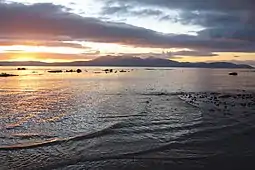 Arran Sunset Taken from Bell Stane, Ardneil Bay, 2007
Arran Sunset Taken from Bell Stane, Ardneil Bay, 2007
The Isle of Arran (/ˈærən/; Scottish Gaelic: Eilean Arainn) or simply Arran is an island off the west coast of Scotland. It is the largest island in the Firth of Clyde and the seventh-largest Scottish island, at 432 square kilometres (167 sq mi). Historically part of Buteshire, it is in the unitary council area of North Ayrshire. In the 2011 census it had a resident population of 4,629. Though culturally and physically similar to the Hebrides, it is separated from them by the Kintyre peninsula. Often referred to as "Scotland in Miniature", the Island is divided into highland and lowland areas by the Highland Boundary Fault and has been described as a "geologist's paradise".
Arran has been continuously inhabited since the early Neolithic period. Numerous prehistoric remains have been found. From the 6th century onwards, Goidelic-speaking peoples from Ireland colonised it and it became a centre of religious activity. In the troubled Viking Age, Arran became the property of the Norwegian crown, until formally absorbed by the kingdom of Scotland in the 13th century. The 19th-century "clearances" led to significant depopulation and the end of the Gaelic language and way of life. The economy and population have recovered in recent years, the main industry being tourism. However, the increase in tourism and people buying holiday homes on the Island, the second highest rate of such homes in the UK, has led to a shortage of affordable homes on the Island. There is a diversity of wildlife, including three species of tree endemic to the area. (Full article...) Image 18The 1966 European Cup Winners' Cup final was an association football match between Borussia Dortmund of West Germany and Liverpool of England played on 5 May 1966 at Hampden Park, Glasgow, Scotland. It was the final match of the 1965–66 season of Europe's secondary cup competition, the European Cup Winners' Cup. Both sides were competing in their first European final.
Image 18The 1966 European Cup Winners' Cup final was an association football match between Borussia Dortmund of West Germany and Liverpool of England played on 5 May 1966 at Hampden Park, Glasgow, Scotland. It was the final match of the 1965–66 season of Europe's secondary cup competition, the European Cup Winners' Cup. Both sides were competing in their first European final.
Each club needed to progress through four rounds to reach the final. The rounds were contested over two legs, with a match at each team's home ground. Borussia's ties varied from close affairs to comfortable victories. They beat Atlético Madrid by a single goal over two legs, while they defeated Floriana 13–1 on aggregate in the first round. Liverpool's ties were mainly close affairs. Only one of Liverpool's ties was won by more than two goals. (Full article...) Image 19Alexander Patrick Greysteil Hore-Ruthven, 2nd Earl of Gowrie, PC, FRSL (26 November 1939 – 24 September 2021), usually known as Grey Gowrie or Lord Gowrie, was an Irish-born British hereditary peer, politician, and businessman. Lord Gowrie was also the hereditary Clan Chief of Clan Ruthven in Scotland. He was educated at Eton and Oxford, and held posts in academia for a period, in the US and London, including time working with poet Robert Lowell and at Harvard University.
Image 19Alexander Patrick Greysteil Hore-Ruthven, 2nd Earl of Gowrie, PC, FRSL (26 November 1939 – 24 September 2021), usually known as Grey Gowrie or Lord Gowrie, was an Irish-born British hereditary peer, politician, and businessman. Lord Gowrie was also the hereditary Clan Chief of Clan Ruthven in Scotland. He was educated at Eton and Oxford, and held posts in academia for a period, in the US and London, including time working with poet Robert Lowell and at Harvard University.
Gowrie was a Conservative Party politician for some years, including a period in the British Cabinet. He held ministerial posts under Margaret Thatcher, in the areas of employment and Northern Ireland, and was Minister of State for the Arts, as well as Chancellor of the Duchy of Lancaster, with responsibility for Civil Service reform. Offered a promotion to full Secretary of State, with responsibility for education across the UK, he turned it down. Previously an arts dealer, he moved to Sotheby's for a reputed salary of around £150,000, chairing parts of the art auction business. He later chaired the Arts Council of England (1994–1998). (Full article...) Image 20
Image 20 Scafell Pike in the Lake District in Cumbria. Scafell Pike is the highest mountain in England, the 257th-highest mountain in the British Isles on the Simms classification, the 138th-highest mountain on the Marilyn classification, and the 46th-highest mountain on the P600 classification. Scafell Pike has the 13th-greatest "relative height" (or prominence) in the British Isles. It is also classed as a HuMP, a Furth, a Hewitt, a Nuttall, a Wainwright, a Birkett, and a County Top.
Scafell Pike in the Lake District in Cumbria. Scafell Pike is the highest mountain in England, the 257th-highest mountain in the British Isles on the Simms classification, the 138th-highest mountain on the Marilyn classification, and the 46th-highest mountain on the P600 classification. Scafell Pike has the 13th-greatest "relative height" (or prominence) in the British Isles. It is also classed as a HuMP, a Furth, a Hewitt, a Nuttall, a Wainwright, a Birkett, and a County Top.
The mountains and hills of the British Isles are categorised into various lists based on different combinations of elevation, prominence, and other criteria such as isolation. These lists are used for peak bagging, whereby hillwalkers attempt to reach all the summits on a given list, the oldest being the 282 Munros in Scotland, created in 1891.
A height above 2,000 ft, or more latterly 610 m, is considered necessary to be classified as a mountain – as opposed to a hill – in the British Isles. With the exception of Munros, all the lists require a prominence above 15 metres (49.21 ft). A prominence of between 15 and 30 metres (49.21 and 98.43 ft) (e.g. some Nuttalls and Vandeleur-Lynams), does not meet the International Climbing and Mountaineering Federation (UIAA) definition of an "independent peak", which is a threshold over 30 metres (98 ft). Most lists consider a prominence between 30 and 150 metres (98.43 and 492.1 ft) as a "top" (e.g. many Hewitts and Simms). Marilyns, meanwhile, have a prominence above 150 metres (492.1 ft), with no additional height threshold. They range from small 150-metre (490 ft) hills to the largest mountains. Prominences above 600 metres (1,969 ft), meet the P600 (the "Majors") classification, which is the UIAA international classification of a "major" mountain. (Full article...) Image 21
Image 21.jpg.webp) Lord Pitfour
Lord Pitfour
James Ferguson, Lord Pitfour (1700 – 25 June 1777) was a Scottish advocate and second Laird of Pitfour, a large estate in Buchan. His flourishing law practice was sited opposite Parliament House in Edinburgh. He became Dean of the Faculty of Advocates in 1760 and was elevated to the bench as Lord Pitfour, in 1764.
Pitfour was described as one of the greatest lawyers in the country. However, by the time he became a Senator of the College of Justice he was past his prime intellectually and thus did not make much of an impact in that role. A Jacobite sympathiser, he is best known for his defence of rebels standing trial at Carlisle after the Jacobite risings. (Full article...) Image 22
Image 22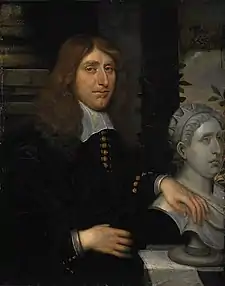 John Mylne, painted by an unknown artist around 1650
John Mylne, painted by an unknown artist around 1650
John Mylne (1611 – 24 December 1667), sometimes known as "John Mylne junior", or "the Younger", was a Scottish master mason and architect who served as Master Mason to the Crown of Scotland. Born in Perth, he was the son of John Mylne, also a master mason, and Isobel Wilson.
Practising as a stonemason, he also took on the role of architect, designing as well as building his projects. He was one of the last masters of Scottish Renaissance architecture, before new styles were imported by his successors. Alongside his professional career, he also served as a soldier and politician. He married three times but had no surviving children. (Full article...) Image 23Islay (/ˈaɪlə/ ⓘ EYE-lə; Scottish Gaelic: Ìle, Scots: Ila) is the southernmost island of the Inner Hebrides of Scotland. Known as "The Queen of the Hebrides", it lies in Argyll just south west of Jura and around 40 kilometres (22 nautical miles) north of the Northern Irish coast. The island's capital is Bowmore where the distinctive round Kilarrow Parish Church and a distillery are located. Port Ellen is the main port.
Image 23Islay (/ˈaɪlə/ ⓘ EYE-lə; Scottish Gaelic: Ìle, Scots: Ila) is the southernmost island of the Inner Hebrides of Scotland. Known as "The Queen of the Hebrides", it lies in Argyll just south west of Jura and around 40 kilometres (22 nautical miles) north of the Northern Irish coast. The island's capital is Bowmore where the distinctive round Kilarrow Parish Church and a distillery are located. Port Ellen is the main port.
Islay is the fifth-largest Scottish island and the eighth-largest island of the British Isles, with a total area of almost 620 square kilometres (240 sq mi). There is ample evidence of the prehistoric settlement of Islay and the first written reference may have come in the first century AD. The island had become part of the Gaelic Kingdom of Dál Riata during the Early Middle Ages before being absorbed into the Norse Kingdom of the Isles. (Full article...) Image 24
Image 24.jpg.webp) Official portrait, c. 2008
Official portrait, c. 2008
James Gordon Brown HonFRSE (born 20 February 1951) is a British politician who served as Prime Minister of the United Kingdom and Leader of the Labour Party from 2007 to 2010. He previously served as Chancellor of the Exchequer under Tony Blair from 1997 to 2007. He was Member of Parliament (MP) for Dunfermline East from 1983 to 2005 and, following boundary changes, Kirkcaldy and Cowdenbeath from 2005 to 2015. Brown is both the most recent Labour Party prime minister and the most recent not to be from England.
A doctoral graduate, Brown studied history at the University of Edinburgh, where he was elected Rector in 1972. He spent his early career working as both a lecturer at a further education college and a television journalist. Brown was elected to the House of Commons at the 1983 general election as the MP for Dunfermline East, later becoming the MP for Kirkcaldy and Cowdenbeath in 2005. He joined the Shadow Cabinet in 1989 as Shadow Secretary of State for Trade, and was later promoted to become Shadow Chancellor of the Exchequer in 1992. Following Labour's victory in the 1997 general election, its largest landslide general election victory in history, Brown was appointed as Chancellor of the Exchequer, becoming the longest-serving holder of that office in modern history. (Full article...) Image 25
Image 25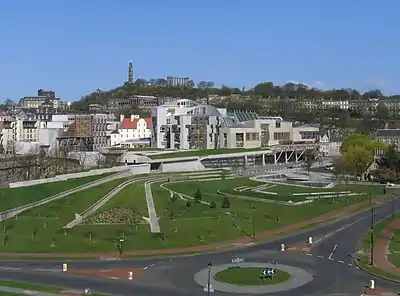 The Scottish Parliament Building at Holyrood designed by the Catalan architect Enric Miralles and opened in October 2004.
The Scottish Parliament Building at Holyrood designed by the Catalan architect Enric Miralles and opened in October 2004.
The architecture of Scotland includes all human building within the modern borders of Scotland, from the Neolithic era to the present day. The earliest surviving houses go back around 9500 years, and the first villages 6000 years: Skara Brae on the Mainland of Orkney being the earliest preserved example in Europe. Crannogs, roundhouses, each built on an artificial island, date from the Bronze Age and stone buildings called Atlantic roundhouses and larger earthwork hill forts from the Iron Age. The arrival of the Romans from about 71 AD led to the creation of forts like that at Trimontium, and a continuous fortification between the Firth of Forth and the Firth of Clyde known as the Antonine Wall, built in the second century AD. Beyond Roman influence, there is evidence of wheelhouses and underground souterrains. After the departure of the Romans there were a series of nucleated hill forts, often utilising major geographical features, as at Dunadd and Dunbarton.
Castles arrived in Scotland with the introduction of feudalism in the twelfth century. Initially these were wooden motte-and-bailey constructions, but many were replaced by stone castles with a high curtain wall. In the late Middle Ages new castles were built, some on a grander scale, and others, particularly in the borders, simpler tower houses. Gunpowder weaponry led to the use of gun ports, platforms to mount guns and walls adapted to resist bombardment. Medieval parish church architecture was typically simpler than in England, but there were grander ecclesiastical buildings in the Gothic style. From the early fifteenth century the introduction of Renaissance styles included the selective use of Romanesque forms in church architecture, as in the nave of Dunkeld Cathedral, followed more directly influenced Renaissance palace building from the late fifteenth century, beginning at Linlithgow. The private houses of aristocrats adopted some of these features and incorporated features of Medieval castles and tower houses into plans based on the French Château to produce the Scots Baronial style. From about 1560, the Reformation led to the widespread destruction of church furnishings, ornaments and decoration and in post-Reformation period a unique form of church emerged based on the T-shaped plan. (Full article...)
Lists of featured content
| This is a list of recognized content, updated weekly by JL-Bot (talk · contribs) (typically on Saturdays). There is no need to edit the list yourself. If an article is missing from the list, make sure it is tagged (e.g. {{WikiProject Scotland}}) or categorized correctly and wait for the next update. See WP:RECOG for configuration options. |
Featured articles
- Áedán mac Gabráin
- Anglo-Scottish war (1650–1652)
- Anne, Queen of Great Britain
- Anne of Denmark
- HMS Argus (I49)
- Japanese battleship Asahi
- Battle of Blenheim
- Blue men of the Minch
- William Bruce (architect)
- William Speirs Bruce
- Burke and Hare murders
- Burnt Candlemas
- Constantine II of Scotland
- Cullen House
- David I of Scotland
- Walter Donaldson (snooker player)
- Donnchadh, Earl of Carrick
- Alec Douglas-Home
- Battle of Dunbar (1650)
- Elgin Cathedral
- Queen Elizabeth The Queen Mother
- Fauna of Scotland
- From the Doctor to My Son Thomas
- Rachel Chiesley, Lady Grange
- Margaret Macpherson Grant
- Great North of Scotland Railway
- Bryan Gunn
- Battle of Halidon Hill
- HMS Hood
- Battle of Inverkeithing
- James II of England
- James VI and I
- Kelpie
- John Knox
- Elizabeth Maitland, Duchess of Lauderdale
- Gregor MacGregor
- Mary, Queen of Scots
- Murray Maxwell
- William McGregor (football)
- Nebula Science Fiction
- Neilston
- Nuckelavee
- Order of the Thistle
- Pitfour estate
- HMS Ramillies (07)
- Renewable energy in Scotland
- Representative peer
- HMS Royal Oak (08)
- Scotland in the High Middle Ages
- Scotland national football team
- Scottish National Antarctic Expedition
- Shapinsay
- Isle of Skye
- Charlotte Stuart, Duchess of Albany
- HMS Vanguard (23)
- Second War of Scottish Independence
- John Wark
- Westminster Assembly
- John Michael Wright
Former featured articles
Good articles
- A82 road
- 2001 Scottish Masters
- 2002 Scottish Masters
- 2014 Scottish Labour leadership election
- 2022 Aberdeen City Council election
- 2022 East Ayrshire Council election
- 2022 North Ayrshire Council election
- 2022 South Ayrshire Council election
- 2022 South Lanarkshire Council election
- Aberdeen F.C.
- Aberdeen F.C.–Rangers F.C. rivalry
- Aberdour Castle
- William Adam (architect)
- Arbroath
- Architecture of Scotland
- Architecture in early modern Scotland
- Architecture in modern Scotland
- Architecture of Scotland in the Industrial Revolution
- Architecture of Scotland in the Middle Ages
- Architecture of Scotland in the Roman era
- Architecture of Scotland in the prehistoric era
- Isle of Arran
- Art in Medieval Scotland
- Art in early modern Scotland
- Art in modern Scotland
- James Balfour (died 1845)
- Battle of Barry
- Jim Baxter
- Ben Nevis
- Lewis Benson (boxer)
- The Bhoys from Seville
- Billy Boys
- The Black Island
- HMS Bonaventure (31)
- Boobrie
- Eilley Bowers
- Bill Bowman (Scottish politician)
- British people
- Gordon Brown
- Brownie (folklore)
- Alexander Buchan (artist)
- Calendar (New Style) Act 1750
- James Campbell (British Army officer, died 1745)
- Camus Cross
- Thomas Carlyle
- Castles in Scotland
- Celtic F.C. in European football
- Celtic Park
- Erik Chisholm
- Church architecture in Scotland
- Winston Churchill
- Clan Maclachlan
- Clydesdale horse
- Coatbridge
- HMS Conqueror (1911)
- The Cookery Book of Lady Clark of Tillypronie
- Coxton Tower
- Craigiehall
- Lord Ninian Crichton-Stuart
- Cruachan Power Station
- Cullen Old Church
- 1966 European Cup Winners' Cup final
- The Daily Mash
- Dandie Dinmont Terrier
- Ruth Davidson
- Demographic history of Scotland
- Paul Dickov
- Mary Docherty
- Donkey Punch (novel)
- Doune Castle
- Dowhill Castle
- Dubh Artach
- Andrew Dudley
- Duncraig Castle
- Dunnottar Castle
- Dunrobin Castle
- Dunstaffnage Castle
- East Kirkton Quarry
- East Stirlingshire F.C.
- Easter Road
- Economy of Scotland in the Middle Ages
- Economy of Scotland in the early modern period
- Edinburgh Castle
- University of Edinburgh
- Edinburgh Zoo
- Education in Medieval Scotland
- Education in early modern Scotland
- Edzell Castle
- Eidyn
- Elcho Castle
- English invasion of Scotland (1400)
- Eriskay Pony
- Estate houses in Scotland
- Evanton
- 1884 FA Cup final
- Edward G. Faile
- Fairy Flag
- Falkirk Wheel
- Family in early modern Scotland
- James Ferguson, Lord Pitfour
- James Ferguson (Scottish politician)
- Finnieston Crane
- Flag of Scotland
- Flora of Scotland
- Sir Ewan Forbes, 11th Baronet
- Forglen House
- Forth Bridge
- Forth Valley Royal Hospital
- Château Gaillard
- Ryan Gauld
- Geography of Scotland in the Middle Ages
- Geography of Scotland in the early modern era
- Geology of Scotland
- Giffnock
- Gilli (Hebridean earl)
- Glass Swords
- The Glenlivet distillery
- Glenrothes
- Glorious Revolution in Scotland
- Government in early modern Scotland
- Government in medieval Scotland
- Isobel Gowdie
- Grey Gowrie
- John Gregorson Campbell
- Hampden Park
- Hibernian F.C.
- Highland cattle
- Highlands and Islands Alliance
- Lists of mountains and hills in the British Isles
- Hillforts in Scotland
- History of Scotland
- History of agriculture in Scotland
- Mary Hogarth
- Housing in Scotland
- How the Scots Invented the Modern World
- Leslie Hunter
- HMS Hurst Castle
- Ibrox Stadium
- 1902 Ibrox disaster
- Inchdrewer Castle
- Inner Hebrides
- James Innes (British Army officer, died 1759)
- Charles Irving (surgeon)
- Islands of the Clyde
- Islay
- James I of Scotland
- Bert Jansch
- Jarlshof
- Jocky Wilson Cup
- Kelvin Scottish
- Battle of Kinghorn
- Kirkandrews, Dumfries and Galloway
- Kirkcaldy
- Kirkcudbright Tolbooth
- Labour Party of Scotland
- Johann Lamont
- Landscape painting in Scotland
- Billy Liddell
- Literature in early modern Scotland
- Kim Little
- Loch Arkaig treasure
- Lochleven Castle
- RAF Lossiemouth
- Murder of Alesha MacPhail
- Clan MacAulay
- Doris Mackinnon
- Sorley MacLean
- Richard Madden
- SS Manasoo
- James Clerk Maxwell
- Maybole Castle
- James McAvoy
- Stuart McCall
- Angus McDonald (Virginia militiaman)
- McEwan's
- Ewan McGregor
- Johnny McNichol
- Meantime (book)
- Mingulay
- Colin Mitchell
- Michelle Mone, Baroness Mone
- Monifieth
- William Montgomerie
- James Murray, Lord Philiphaugh
- Music in early modern Scotland
- John Mylne (died 1667)
- The National (Scotland)
- John Ogilby
- One Kiss
- Orkney
- Outer Hebrides
- Paisley witches
- Papa Stour
- Partick Thistle F.C.
- Portrait painting in Scotland
- Potion (song)
- Prehistoric art in Scotland
- Raasay
- RAF Machrihanish
- Ragnall ua Ímair
- Alex Raisbeck
- Rangers F.C. signing policy
- Renaissance in Scotland
- Richard Rennison
- Rockstar Dundee
- Romanticism in Scotland
- Andrew Ross (rugby union, born 1879)
- Royal Banner of Scotland
- Rusco Tower
- St Margaret's Church, Aberlour
- St Peter's Roman Catholic Church, Buckie
- St Rufus Church
- Scandinavian Scotland
- Schiehallion experiment
- Scotland during the Roman Empire
- Scotland in the Middle Ages
- Scotland in the early modern period
- Scotland in the late Middle Ages
- Scotland in the modern era
- Scotland national football team manager
- Scotland under the Commonwealth
- Scottish art
- 1999 Scottish Challenge Cup final
- 2002 Scottish Challenge Cup final
- 2007 Scottish Challenge Cup final
- Scottish Challenge Cup
- 1873–74 Scottish Cup
- 2012 Scottish Cup final
- 2019 Scottish Open (snooker)
- 1971 Scottish soldiers' killings
- Scottish Terrier
- Scottish art in the eighteenth century
- Scottish art in the nineteenth century
- Scottish religion in the eighteenth century
- Scottish religion in the seventeenth century
- Scottish society in the Middle Ages
- Scottish society in the early modern era
- Scuttling of the German fleet at Scapa Flow
- Sea Mither
- Bill Shankly
- Shetland
- Shieling
- Sieges of Berwick (1355 and 1356)
- Ian Smith (rugby union, born 1903)
- Jimmy Speirs
- Staffa
- Jessie Stephen
- Alexander Stoddart
- Stoor worm
- John Struthers (anatomist)
- Charles Edward Stuart
- Sundrum Castle
- Tay Whale
- D'Arcy Wentworth Thompson
- Thurso
- Tibbers Castle
- Titan Clydebank
- Torf-Einarr
- Tradeston Flour Mills explosion
- Trident (UK nuclear programme)
- USS Tucker (DD-374)
- German submarine U-27 (1936)
- Urquhart Castle
- James Walker (Australian politician)
- James Walker (Royal Navy officer)
- William Middleton Wallace
- Warfare in Medieval Scotland
- Warfare in early modern Scotland
- Water bull
- West Highland White Terrier
- Robert White (Virginia physician)
- Krysty Wilson-Cairns
- Witch trials in early modern Scotland
- Andrew Wodrow
- Women in early modern Scotland
Former good articles
- Alexander Bain (inventor)
- Billy Bremner
- William Buchanan (locomotive designer)
- Canadian Gaelic
- Andrew Carnegie
- Carnoustie
- Catherine Cranston
- Arthur Conan Doyle
- Dundee United F.C.
- Steve Evans (footballer, born 1962)
- Forth Road Bridge
- Glasgow
- Glasgow, Paisley, Kilmarnock and Ayr Railway
- University of Glasgow
- Frank Hadden
- Halloween
- David Hume
- Deborah Kerr
- Lothian Buses
- Gillian McKeith
- Andy Murray
- Picts
- Scotland
- Scots language
- Still Game
- Alec Sutherland
- Tay Bridge
- Treasure Island
- William Morrison (chemist)
Featured lists
- List of islands of Scotland
- List of Celtic F.C. managers
- List of Scottish Football League clubs
- List of Scotland international footballers
- List of Scotland ODI cricketers
- List of Scotland national football team hat-tricks
- List of Scottish football champions
- List of Scottish football clubs in the FA Cup
- PFA Scotland Players' Player of the Year
- SFWA Footballer of the Year
- Scotland national football team results (1872–1914)
- Timeline of prehistoric Scotland
- Timeline of Scottish football
Featured pictures
 13-06-07 RaR Biffy Clyro Simon Neil 02
13-06-07 RaR Biffy Clyro Simon Neil 02 Aerial View of Edinburgh, by Alfred Buckham, from about 1920
Aerial View of Edinburgh, by Alfred Buckham, from about 1920 Arthur-James-Balfour-1st-Earl-of-Balfour
Arthur-James-Balfour-1st-Earl-of-Balfour.jpg.webp) CAMPBELL, George W-Treasury (BEP engraved portrait)
CAMPBELL, George W-Treasury (BEP engraved portrait) Charles Robert Leslie - Sir Walter Scott - Ravenswood and Lucy at the Mermaiden's Well - Bride of Lammermoor
Charles Robert Leslie - Sir Walter Scott - Ravenswood and Lucy at the Mermaiden's Well - Bride of Lammermoor_2.jpg.webp) Common seal (Phoca vitulina) 2
Common seal (Phoca vitulina) 2 Dalziel Brothers - Sir Walter Scott - The Talisman - Sir Kenneth before the King
Dalziel Brothers - Sir Walter Scott - The Talisman - Sir Kenneth before the King Daniel Craig McCallum by The Brady National Photographic Art Gallery
Daniel Craig McCallum by The Brady National Photographic Art Gallery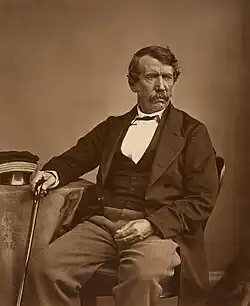 David Livingstone by Thomas Annan
David Livingstone by Thomas Annan.jpg.webp) Dunrobin Castle -Sutherland -Scotland-26May2008 (2)
Dunrobin Castle -Sutherland -Scotland-26May2008 (2)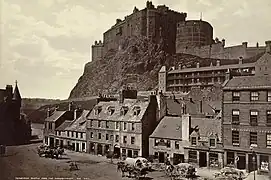 Edinburgh Castle from Grass Market
Edinburgh Castle from Grass Market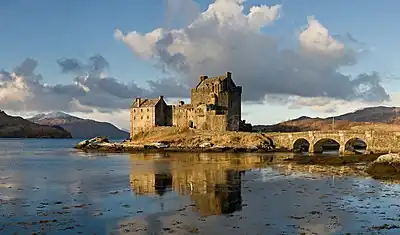 Eilean Donan Castle, Scotland - Jan 2011
Eilean Donan Castle, Scotland - Jan 2011- Falkirk Wheel Timelapse, Scotland - Diliff
 FalkirkWheelSide 2004 SeanMcClean
FalkirkWheelSide 2004 SeanMcClean Gavin Hamilton - Coriolanus Act V, Scene III edit2
Gavin Hamilton - Coriolanus Act V, Scene III edit2 Jaguar at Edinburgh Zoo
Jaguar at Edinburgh Zoo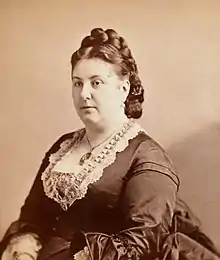 Jeremiah Gurney - Photograph of Euphrosyne Parepa-Rosa
Jeremiah Gurney - Photograph of Euphrosyne Parepa-Rosa Loch Torridon, Scotland
Loch Torridon, Scotland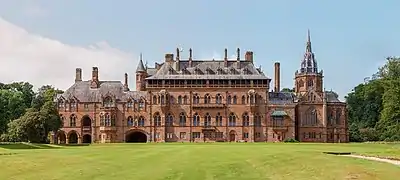 Mount Stuart House 2018-08-25
Mount Stuart House 2018-08-25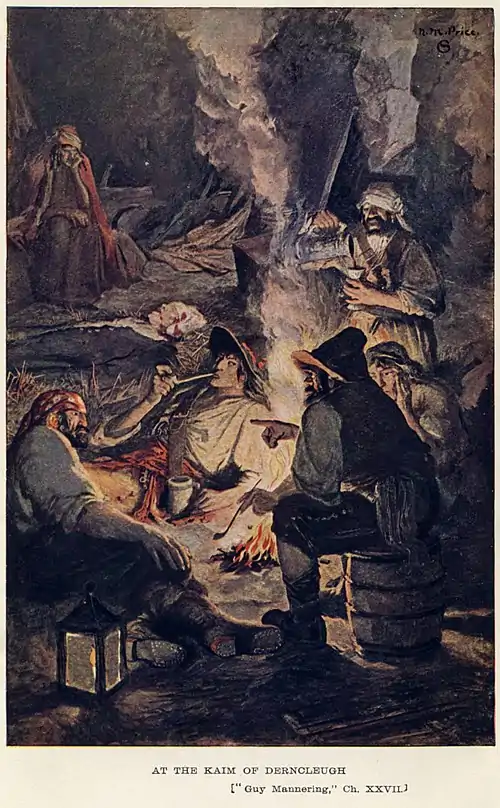 N. M. Price - Sir Walter Scott - Guy Mannering - At the Kaim of Derncleugh
N. M. Price - Sir Walter Scott - Guy Mannering - At the Kaim of Derncleugh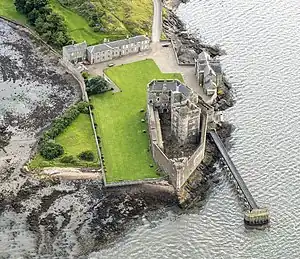 NEWScotland-2016-Aerial-Blackness Castle 01
NEWScotland-2016-Aerial-Blackness Castle 01 Nils Olav inspects the Kings Guard of Norway after being bestowed with a knighthood at Edinburgh Zoo in Scotland
Nils Olav inspects the Kings Guard of Norway after being bestowed with a knighthood at Edinburgh Zoo in Scotland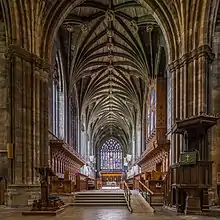 Paisley Abbey Interior East
Paisley Abbey Interior East Paisley Abbey from the south east
Paisley Abbey from the south east Prince James Francis Edward Stuart by Alexis Simon Belle
Prince James Francis Edward Stuart by Alexis Simon Belle Robert William Thomson - Illustrated London News March 29 1873
Robert William Thomson - Illustrated London News March 29 1873 Scotland-2016-West Lothian-Hopetoun House 02
Scotland-2016-West Lothian-Hopetoun House 02 Sgùrr nan Gillean from Sligachan, Isle of Skye, Scotland - Diliff
Sgùrr nan Gillean from Sligachan, Isle of Skye, Scotland - Diliff_-_Google_Art_Project.jpg.webp) Sir Anthony Van Dyck - Charles I (1600-49) - Google Art Project
Sir Anthony Van Dyck - Charles I (1600-49) - Google Art Project St Matthew's Church - Paisley - Interior - 5
St Matthew's Church - Paisley - Interior - 5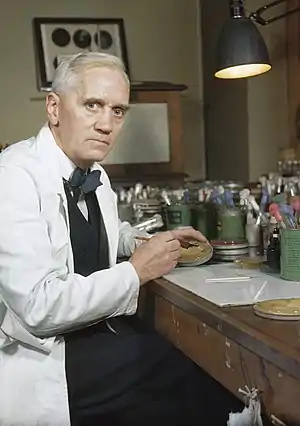 Synthetic Production of Penicillin TR1468
Synthetic Production of Penicillin TR1468 The Air Ministry, 1939-1945. CH10270 – Edit 1
The Air Ministry, 1939-1945. CH10270 – Edit 1 The Monarch of the Glen, Edwin Landseer, 1851
The Monarch of the Glen, Edwin Landseer, 1851_Skating_on_Duddingston_Loch.jpg.webp) The Skating Minister
The Skating Minister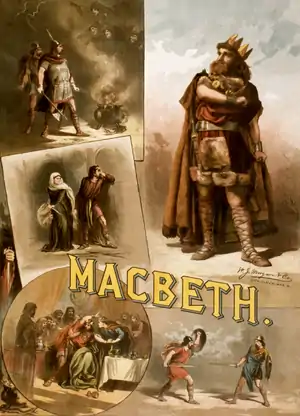 Thomas Keene in Macbeth 1884 Wikipedia crop
Thomas Keene in Macbeth 1884 Wikipedia crop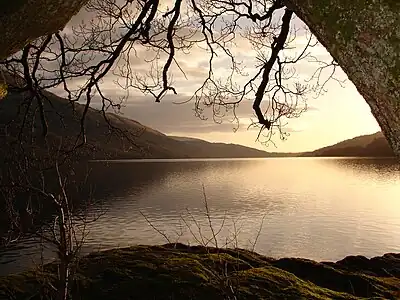 View of loch lomond
View of loch lomond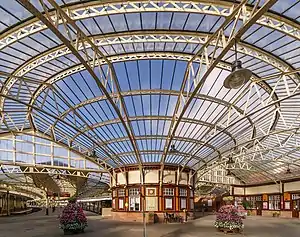 Wemyss Bay railway station concourse 2018-08-25 2
Wemyss Bay railway station concourse 2018-08-25 2 William John Macquorn Rankine by Thomas Annan
William John Macquorn Rankine by Thomas Annan
Get involved
| ||||||||||||||||||||||||||||||
For editor resources and to collaborate with other editors on improving Wikipedia's Scotland-related articles, see WikiProject Scotland.
To get involved in helping to improve Wikipedia's Scotland related content, please consider doing some of the following tasks or joining one or more of the associated Wikiprojects:
- Visit the Scottish Wikipedians' notice board and help to write new Scotland-related articles, and expand and improve existing ones.
- Visit Wikipedia:WikiProject Scotland/Assessment, and help out by assessing unrated Scottish articles.
- Add the Project Banner to Scottish articles around Wikipedia.
- Participate in WikiProject Scotland's Peer Review, including responding to PR requests and nominating Scottish articles.
- Help nominate and select new content for the Scotland portal.
Do you have a question about The Scotland Portal that you can't find the answer to?
Post a question on the Talk Page or consider asking it at the Wikipedia reference desk.
Related portals
Wikipedia in other relevant languages
Associated Wikimedia
The following Wikimedia Foundation sister projects provide more on this subject:
-
 Commons
Commons
Free media repository -
 Wikibooks
Wikibooks
Free textbooks and manuals -
 Wikidata
Wikidata
Free knowledge base -
 Wikinews
Wikinews
Free-content news -
 Wikiquote
Wikiquote
Collection of quotations -
 Wikisource
Wikisource
Free-content library -
 Wikispecies
Wikispecies
Directory of species -
 Wikiversity
Wikiversity
Free learning tools -
 Wikivoyage
Wikivoyage
Free travel guide -
 Wiktionary
Wiktionary
Dictionary and thesaurus
This article is issued from Wikipedia. The text is licensed under Creative Commons - Attribution - Sharealike. Additional terms may apply for the media files.

